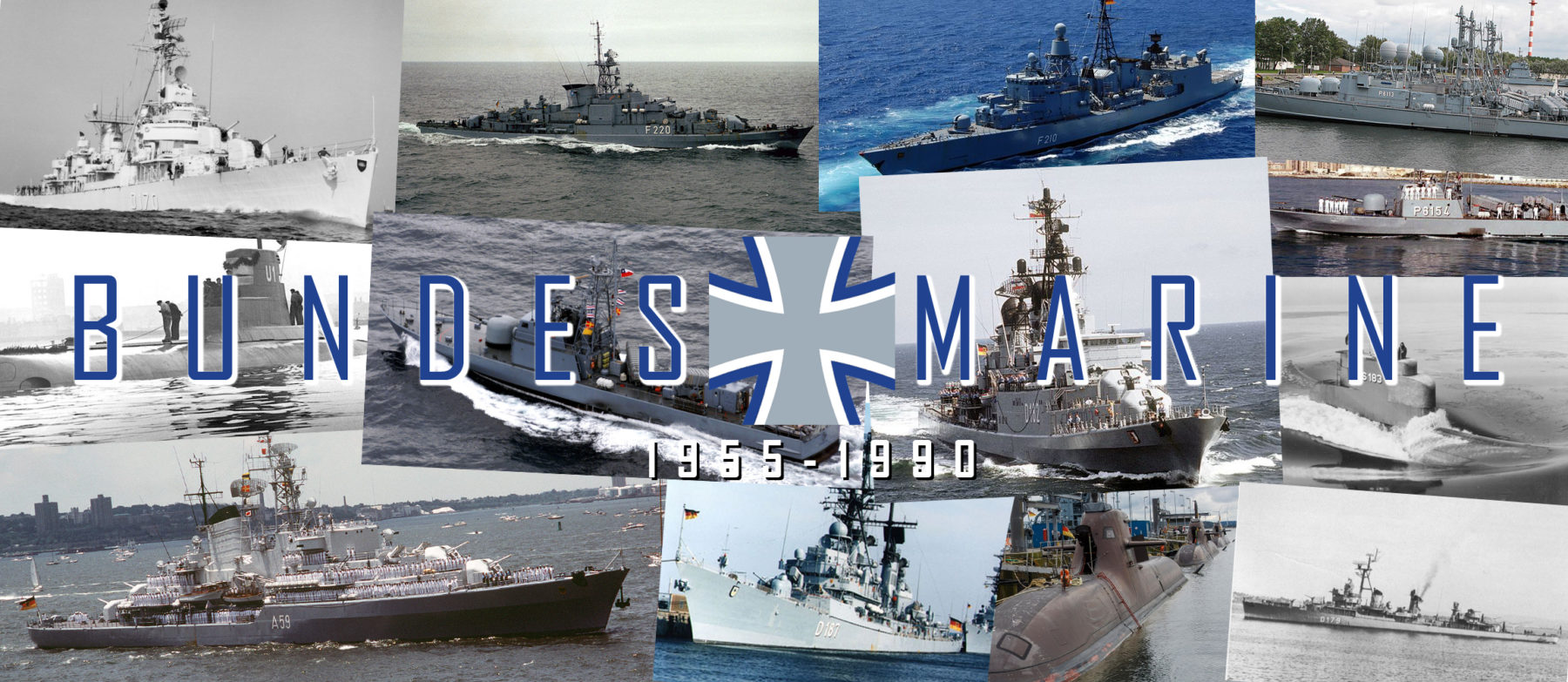
 The Bundesmarine: Guarding the Baltic
The Bundesmarine: Guarding the Baltic
Circa 122 ships 1945-1990
The German Navy is one of these institutions that passed through an exceptionally tumultuous history linked to the country’s creation, which began with the Prussians in the 1700s as the Preußische Marine, became the Reichsflotte in 1850, the North German Federal Navy until 1870, then the Kaiserliche Marine until 1919, the Reichsmarine until 1933, then the Kriegsmarine until 1945, the German Mine Sweeping Administration until 1948, and with the decision to let Germany rearm inside NATO, the Bundesmarine from 1956 until 1990. It’s part of the Bundeswehr at large, the German federal army.
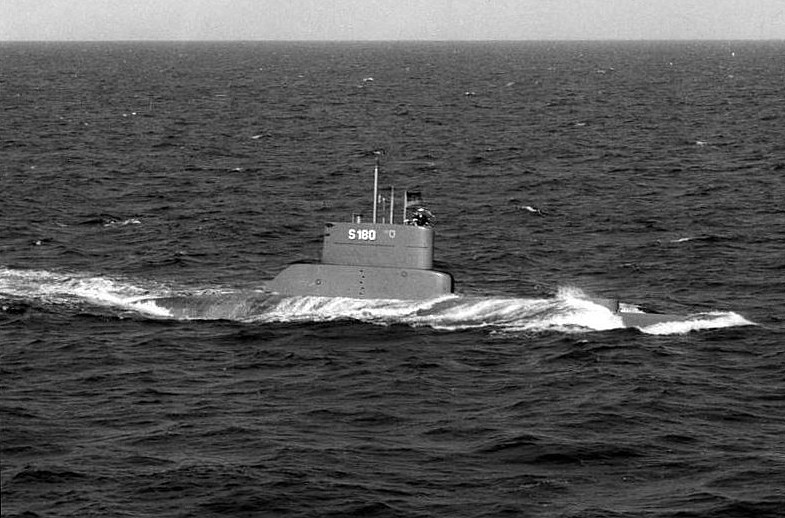
Capitalizing on its ww2 expertise in submarines, Federal Germany built far more of this type for export than any other country to date German shipyards are in fact world champions in exporting conventional submarines, with more than 120 sold to 17 countries, on four continents. In comparison, the Bundesmarine had at all times in the cold war about 15 at sea. Here, the U-1 of the Type 205.
Articles published and Planned
- Brandenburg class Frigate (1992)
- Bremen class Frigates
- Deutschland (1960)
- Gneisenau class Frigates
- Köln class frigates (1961)
- Lütjens class Destroyers (1965)
- Type 101 Hamburg class destroyers (1960)
- Type 201 class submarines (1960)
- Type 205 submarines (1962)
- Type 206 submarines
- Type 209 Submarines (1972)
- Zerstörer class destroyers (1958)
Frigates
Scharnhorst class Frigates (1959)
Köln class Frigates (1958)
Bremen class Frigates (1979)
Brandenbug class Frigates (1992)
German cold-war subs (generic)
Type 205 class SSK (1962)
Type 206 class SSK (1971)
Type 209 (export) SSK (1972)
Misc.
Bundesmarine amphibious ships
Thetis class corvettes
Corvette Hans Burkner
Rhein class suppert ships
Mosel class support ships
Lahn class support ships
Fast Attack Crafts
Silbermöwe class FACs
Jaguar class FACs
Hugin/Pfeil FACs
Zobel class FACs
S41 class FACs
S61 class FACs
S71 class FACs
KW class PBs
Kw 15 class PBs
Neustadt class PBs
Mine warfare vessels
Bamberg class minelayers
Sachsenwald class mine transports
Type 319 minesweepers
Lindau class minesweepers
Vegesack class minesweepers
Schutze class minesweepers
Bundesmarine R Boote
Hansa inshore Ms.
Ariadne class inshore Ms.
Frauenlob class inshore Ms.
Holnis class indhore Ms.
Hameln class indhore Ms.
Frankentahl class indhore Ms.
Today the Bundesmarine is a shadow of its past self, especially the humongus Kaiserliches Marine that almost became the second world’s largest, compounded by NATO’s strict missions and policies for the Baltic and budget cuts following the end of the cold war. Nevertheless, what the Bundesmarine could not do in terms of domestic needs, more than compensated in exports, especially through the very successful line of diesel-eletric submarines, MEKO frigates, Lürssen’s FACs and numerous weaponry and detection, mine warfare systems which allowed the domestic German naval industry to punch well above its weight. Nevertheless, the state of the German army in the post-2000 years degraded, that is until the 2022 invasion of Ukraine and massive plan of 100 billion euros, well above other European powers. Impressive on paper, it will be mostly absorbed by the most urgent upkeep needs of the Bundeswehr, and for the Bundesmarine, the current plan is not for expansion but aoso to reach a better operational readiness for its fleet of 65 commissioned ships, 11 frigates, 5 corvettes, 2 minesweepers, 10 minehunters, 6 submarines, 11 replenishment ships and 20 miscellaneous auxiliary vessels for 220,000 tonnes. It is still judged “adequate” for the defence of the Baltic sea given the scale of the Russian Baltic Navy.
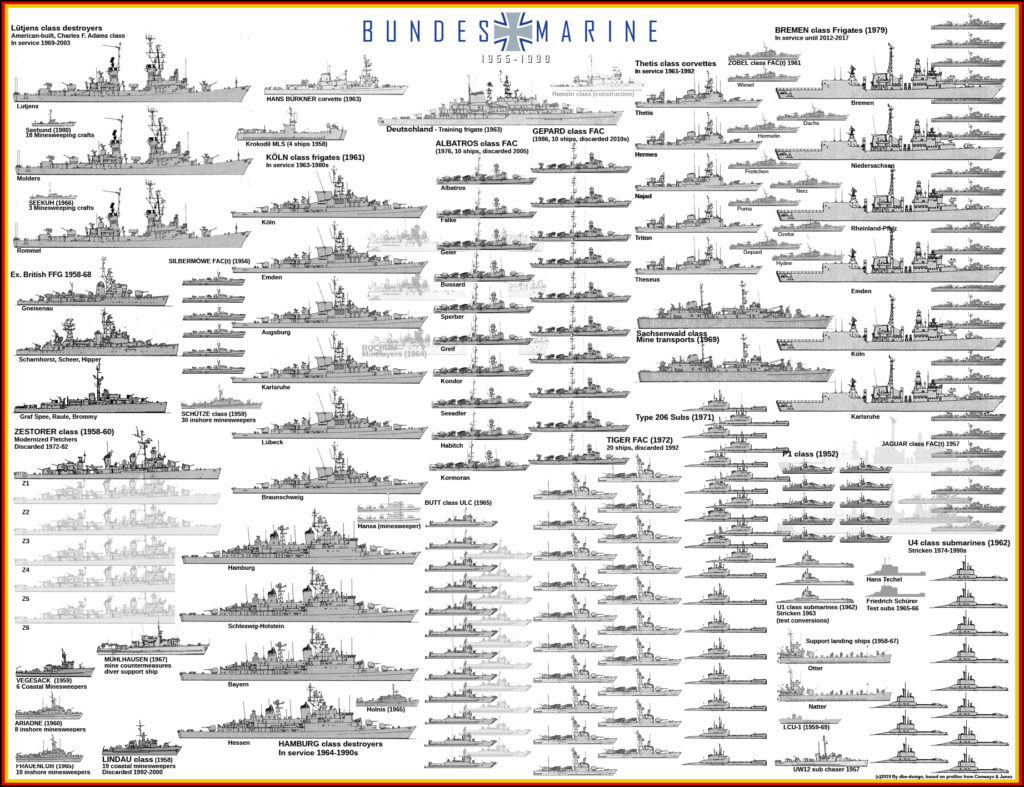
The Bundesmarine in 1990, an attempt to stack in the standard 50×65 cm format all types of ships used since 1955.
The Bundesmarine at its peak in 1990
Before the fall of USSR and reunion with East Germany, the Bundesmarine reached its zenith, with seven destroyers (Four Hamburg and three Lutjens class), thirteen frigates (Köln and Bremen class), one more being completed, a destroyer-size training ship (Deutschland), 23 submarines, six corvettes, 40 FACs, and a hundred miscellaneous ships, from mine transport to mine warfare, landing and support ships. Certainly, the minesweepers fleet aligned at that time was arguably one of the best and largest worldwide.
Mines in the shallow waters of the baltic has been a hinderance, having been largely used during WW2 by several belligerents and even neutrals like Sweden, to the point mine warfare was ongoing until the 1960s through a specific organization that preceded the Bundesmarine. Germany became NATO’s specialist of mine warfare.
Baltic sea lanes were officially “cleaned” of all threat quite late indeed and it’s not rare even to this day ww2 era deriving mines are found and neutralized in these waters.
History: Before the Bundesmarine (1945-55)
Most people would assume a new German Navy was built right when the cold war flared up in 1947. But for some time, rearming Germany was seen as quite an issue in Europe until realpolitik, facing Eastern ambitions and postures readily imposed it. In 1945 the Kriegsmarine had to surrender unconditionally.
In fact, Admiral Dönitz was the last Reich’s legitimate, designated as such by Hitler, head of state, which signed the capitulation almost as his first act.
The fate of the Kriegsmarine: War prizes
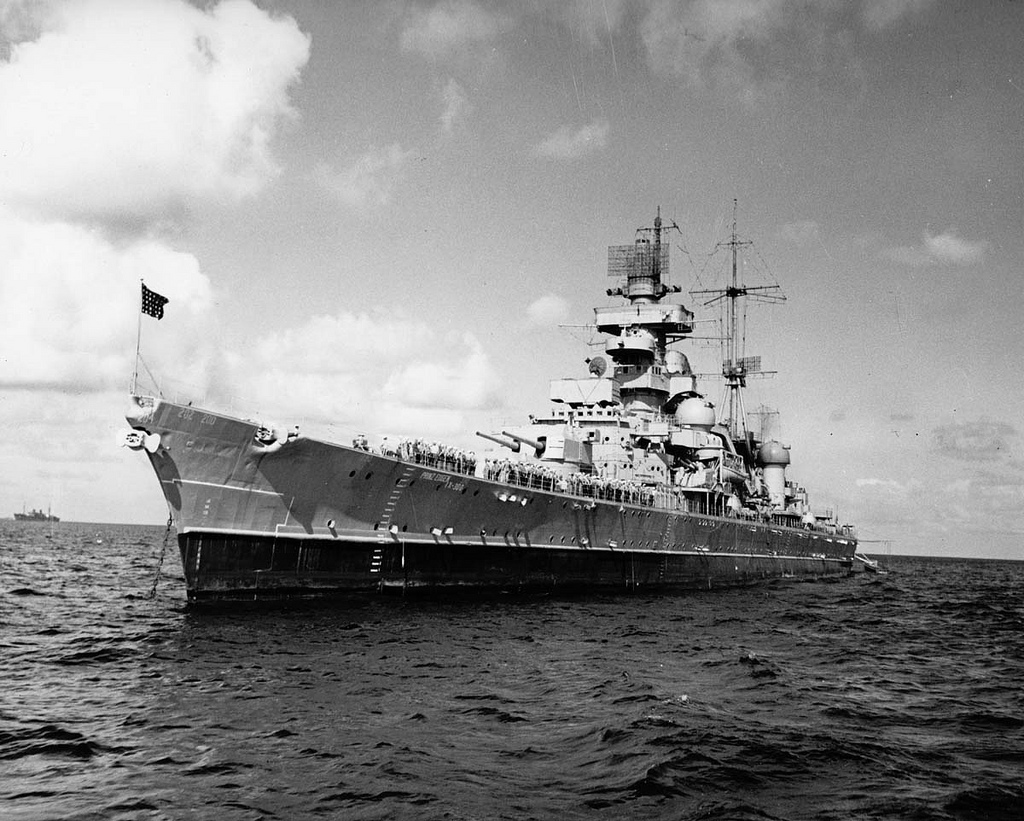 The Prinz Eugen, American war prize was comprehensively studied before ending in the atomic test of Bikini Atoll (Flickr)
The Prinz Eugen, American war prize was comprehensively studied before ending in the atomic test of Bikini Atoll (Flickr)
After peace in Europe was signed, a question soon arose about the fate of surviving Kriegsmarine ships, including a large fleet of state-of-the art U-Bootes. USSR was adamant right from the start about obtaining half of this lot.
Fact is indeed, that the Soviet Navy had suffered badly during the war, loosing most of its surface fleet without wartime replacements. In addition, both the US and Great Britain did not saw the use of German war prizes other than for reverse-engineering some innovative submarines.
After Postdam was signed, a third of the fleet was eventually allocated to the USSR, the remainder being distributed among allied Nations. Shipping was placed under a common organism, the Combined Shipping and Adjustment Board and United Maritime Authority, when the war was still ongoing with Japan.
There was a concern the Germans would keep a substantial coastal and riverine force to help them clear waterways to traffic and regenerate industry after the war, in views of the Marshall plan.
For detailed postwar attributions, see each respective navy.
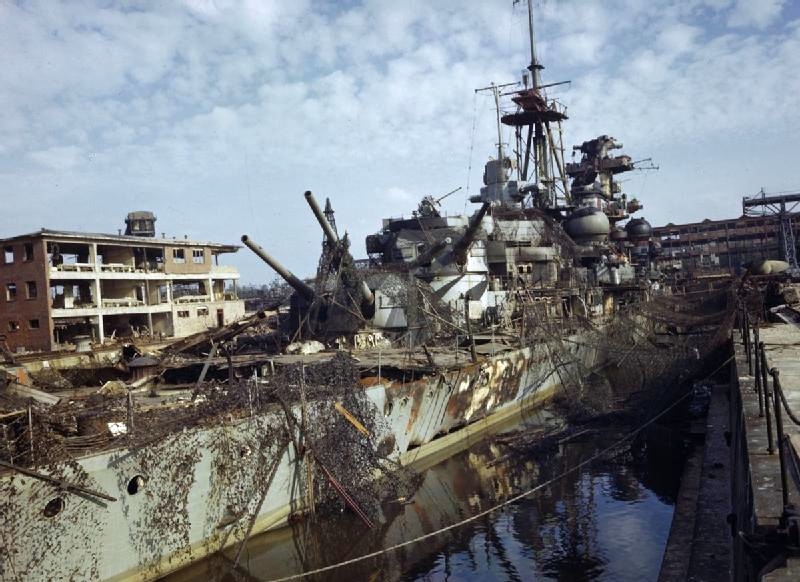 KMS Admiral Hipper captured at Kiel in 1945.
KMS Admiral Hipper captured at Kiel in 1945.
A threat for reconstruction: Mines
Extensive minefields in existence soon also rose also as a major issue. Clearing sea lanes and help local countries to trade and recuperate was a priority alongside the Marshall plan. As soon as June 1945 the Berlin declaration charged Germany of this task. Therefore not only a new organization was soon set up, but it was allocated all means in ships, materials and men as possible.
The GMSA at its peak counted 755 active vessels, including 440 ex-German Kriegsmarine minesweepers, and many converted trawlers and auxiliaries. Personal coumprised mainly ex-Kriegsmarine sailors including some nazi officers, in total 16,000 men under the supervision of British officers. This was seen as a necessary evil in a transition phase.
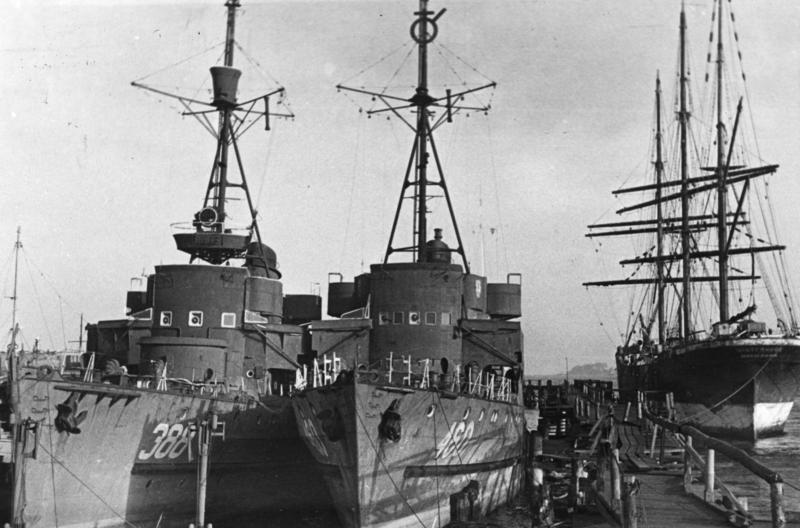
German M-Boote being demilitarized at Kiel in 1949. These were by far the most common German navy ships in service during the first decade postwar (440, including many R-Boote) with the ingrate and dangerous task to clear the Baltic and north sea coast of minefields of several nationalities.
Over the years they will clear up effectively some 580,000 mines. In 1947, the GMSA was disbanded and replaced by the minesweeping unit of the Customs inspection based in Cuxhaven, dependent of the British FIS (Frontier inspection Service) attached to the Royal Navy, which went on its minesweeping tasks until being disbanded in 1951.
By March of the same year a new German independent organism called the German Frontier Inspection Authority replaced it, including in addition to the last fleet, four new patrol boats, three fast attack crafts (Former S-Boote), ten converted trawlers supported by a tanker, a tug two tenders, and small crafts. This embryo of a Navy coincided with the creation of the Federal Republic.
The long road to NATO’s integrated naval policy
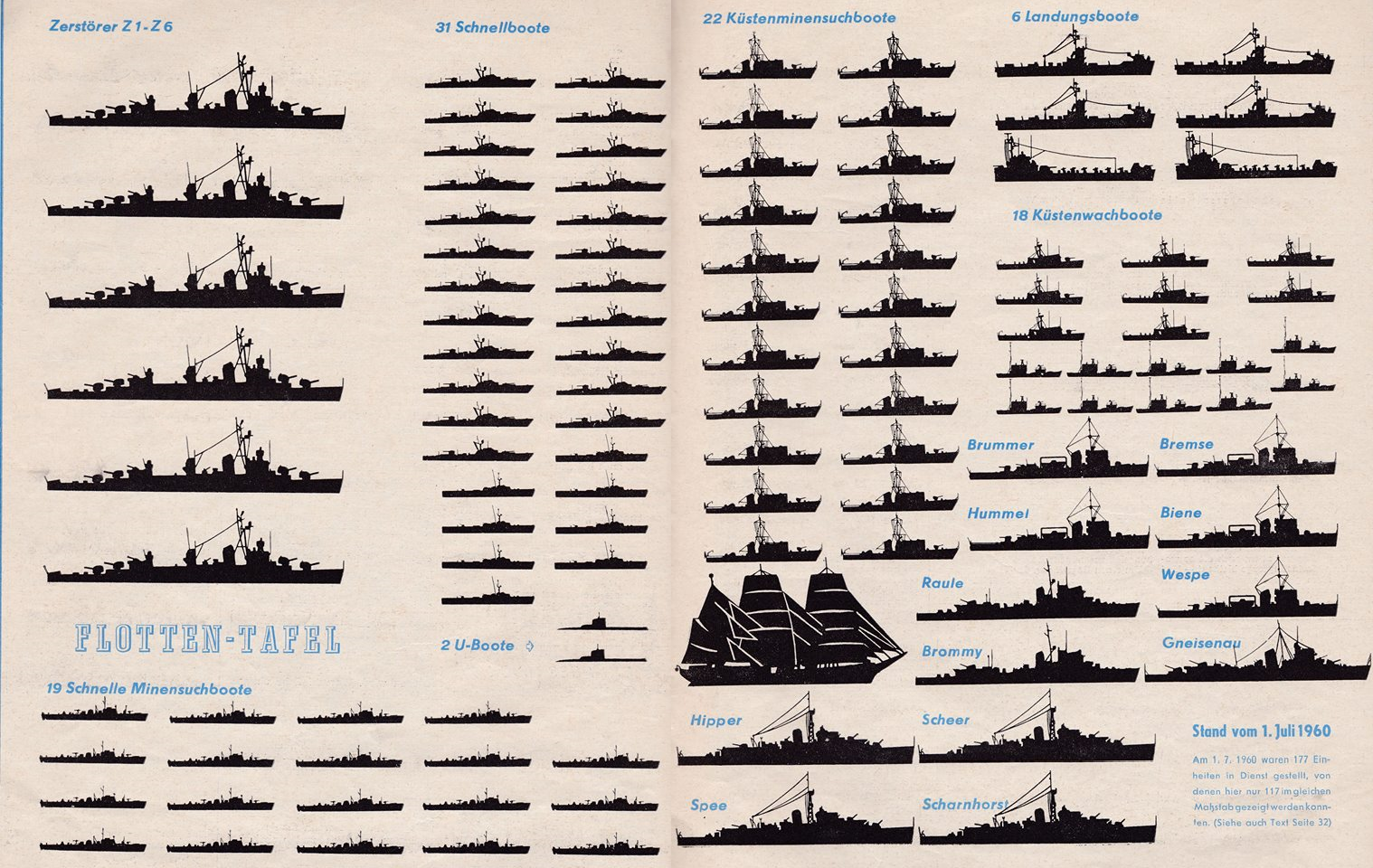
The Bundesmarine in 1960. Not a large fleet.
despite this political step, the renaissance of a fully-fledged navy capable of taking of at least part of the Soviet naval might in the area followed a long and arduous path. In 1949 already they were talks of rearming Germany, which proceeded faster than the naval arm.
Only by May 1955 Germany was integrated into NATO and on 7 June 1955 the new federal defence ministry was created, and its first order dated from 1st January 1956 was to create a naval instruction division, first step for a larger scale naval force. This new organism that replaced the FIA started with just four officers, 24 NCOs, and 140 ratings.
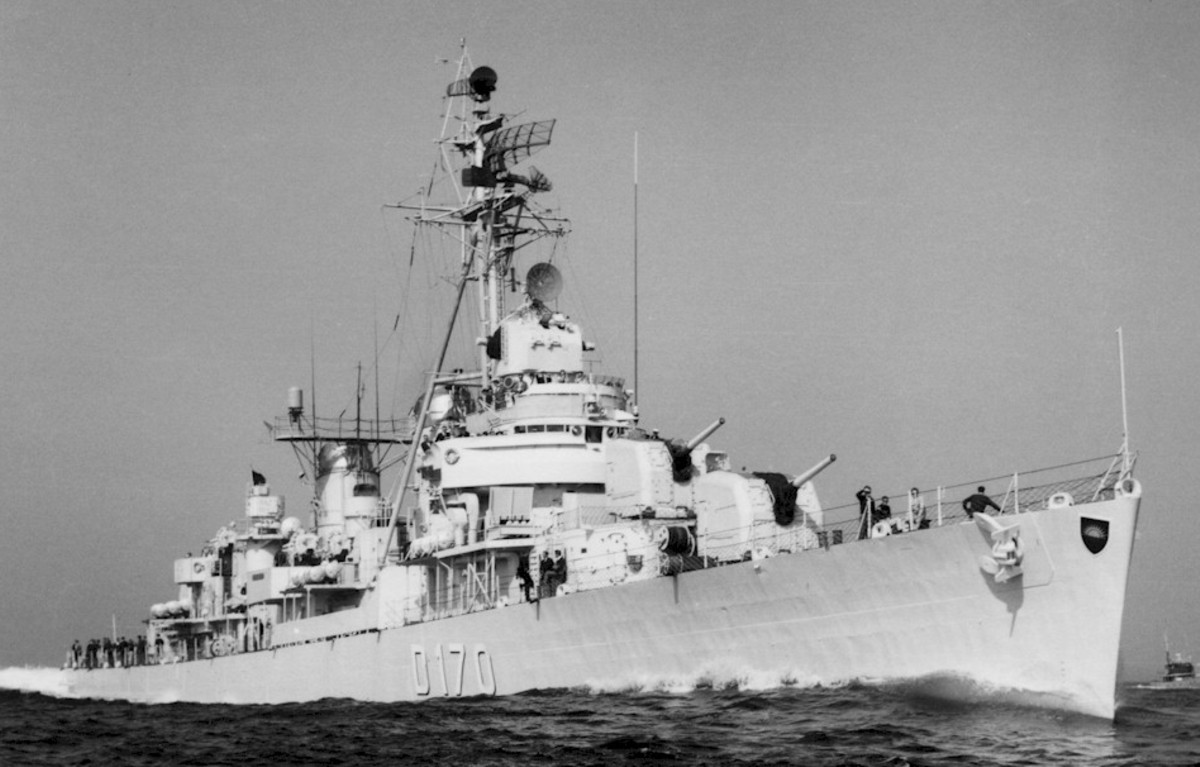
Zestorer class, modernized Fletcher class destroyers
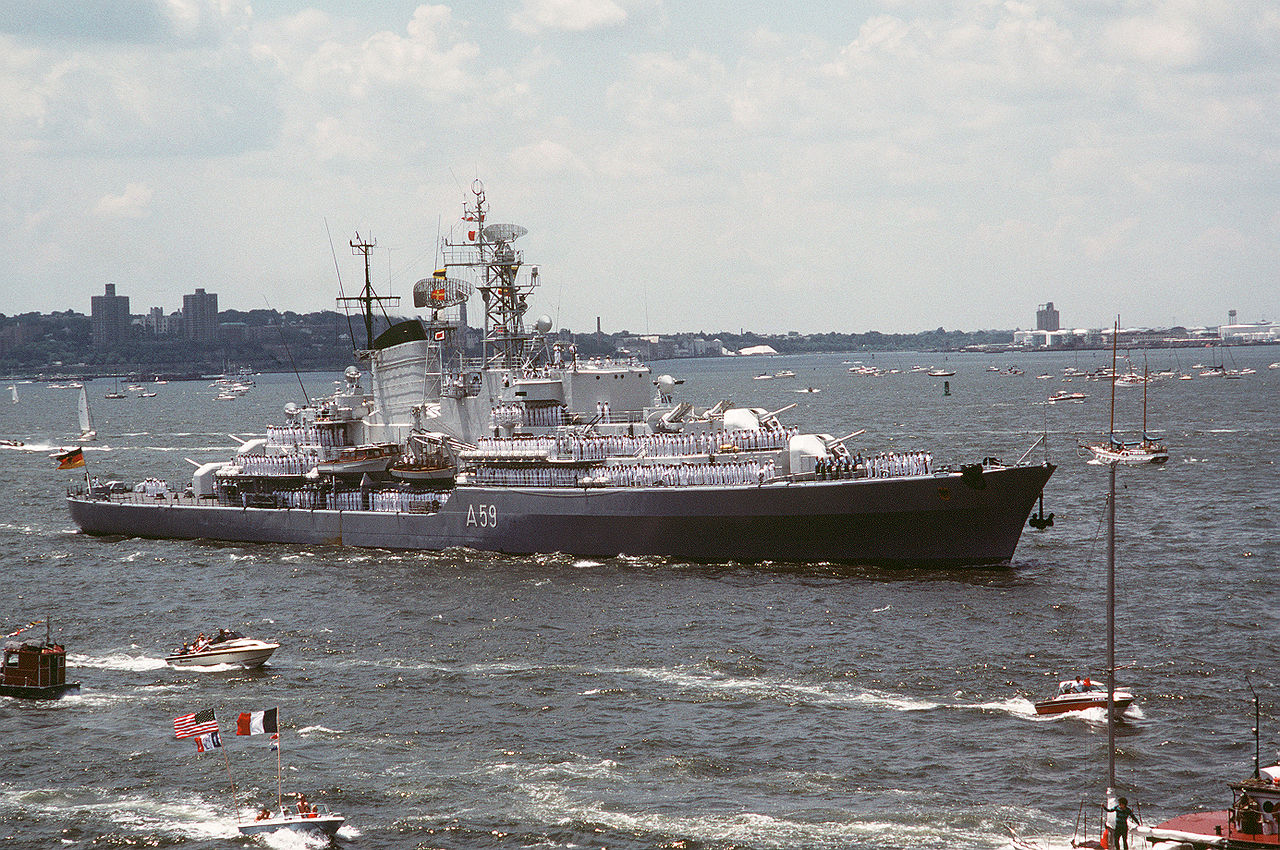 BMS Deutschland (A69) probably the most famous ship of the Bundesmarine in the cold war, symbol of its renaissance, here in New York.
BMS Deutschland (A69) probably the most famous ship of the Bundesmarine in the cold war, symbol of its renaissance, here in New York.
Started in 1957 as a multi-purpose ship able to perform other missions in wartime, she was built at Nobiskrug, Rendsburg and launched in November 1960, only decommissioned in June 1990.
The new force counted in addition to the former ships, ten patrol boats, six MMs boats while many older ships were discarded. To meet new requirements as soon as personal was trained and available, ships were obtained by various sources: Some ex-war prizes were returned, and US and British ships obtained, in particular, 6 frigates and 6 destroyers whereas 14 landing ships were purchased.
The 1950 naval projection plan asked for 12 large attack crafts, 36 MTBs, 24 submarines, 12 ASW escorts, 36 LSIs, 36 minehunters, 12 sub-chasers, 36 patrol boats, 24 minesweepers and a support fleet plus a cover of 114 naval planes, mostly patrollers.
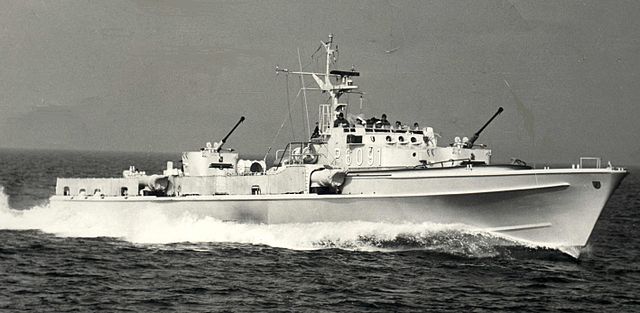
Jaguar class FACs
Of course, it was difficult in the fifties for the new fledgling fleet to manage the great diversity of her ships, maintenance and supply-wise, despite support from allied partners. Time for the German industry and naval yards to catch-up.
In effect, the Bundestag ratified the first naval expansion plan in May 1956, followed by another in 1958, and a third in 1960, which included domestic constructions in larger numbers. This programme enforced in 1961 was to comprise 12 destroyers, 6 frigates, 40 MTBs (future FACs), 12 submarines, 52 minesweepers and 120 auxiliaries plus 58 naval planes.
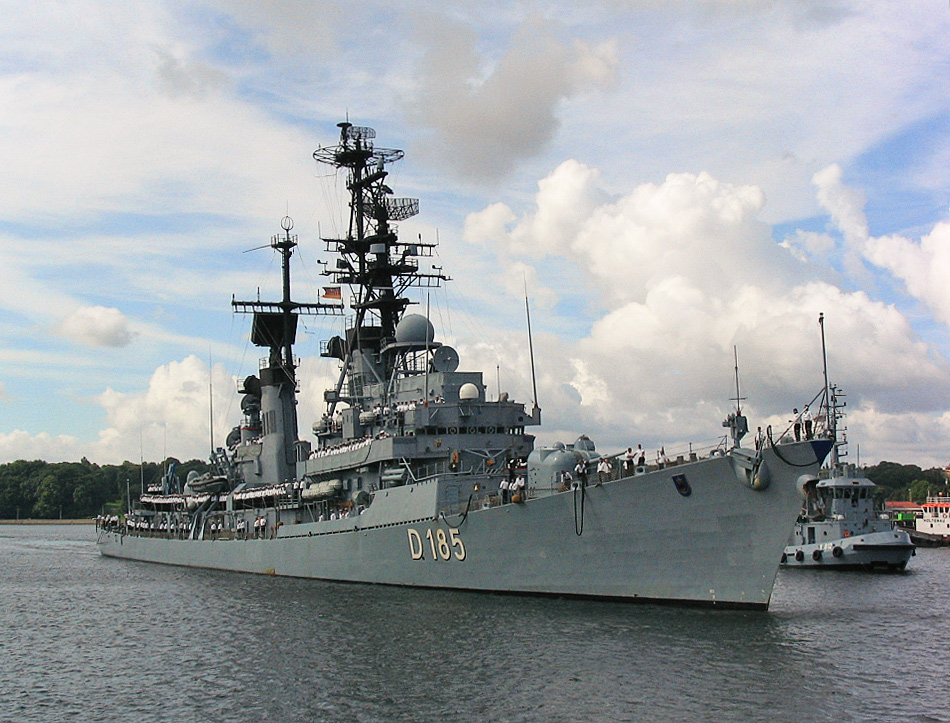 Although technically American-built, modernized copies of the well-known Charles F Adams class (1958), the Lutjens, Molders and Rommel (Type 103 DD) launched at Bath Iron Works in 1967-69 formed the “AA division” of German destroyers during the cold war, whereas the German-built Hamburg class (Type 101) were more anti-ship/ASW oriented. All three were deactivated well after the end of the cold war, in 1998 and 2008 for the last two.
Although technically American-built, modernized copies of the well-known Charles F Adams class (1958), the Lutjens, Molders and Rommel (Type 103 DD) launched at Bath Iron Works in 1967-69 formed the “AA division” of German destroyers during the cold war, whereas the German-built Hamburg class (Type 101) were more anti-ship/ASW oriented. All three were deactivated well after the end of the cold war, in 1998 and 2008 for the last two.
In 1965 the Bundesmarine took its final cold war shape for the 25 years to come, with six Type 119 and four Type 101 destroyers, six Type 120 frigates, 50 FACs of various types, 30 submarines and 60 minesweepers of various types plus many tenders, tankers and training ships.
In fact, only part of the plan was concluded (like the cancellation of the six landing ships), although increases took place, in particular for FACs. In the 1970s the Bundesmarine was integrated in the North Atlantic command (STANAVFORLANT) and in the 1990s even in the Mediterranean standing force, in addition to the Channel force.
Lürssen-built S71 class Gepard (1981) armed with MM38 exocet missiles.
Within NATO, the Bundesmarine was to operate under a “forward defence” doctrine and multiplied bi- and multi-national naval exercises, especially in the 1980s as the cold war heated again.
The goal of these combined operations was to maintain a high degree of standardization in practices in the most likely scenario of combined operations in the Baltic, and the North sea entrance as the Soviet North sea could have been poised to join the Baltic fleet.
As for standards, the fleet used diesel-electric scheme (CODOG) with considerable expertise dating back from the Kriegsmarine days, and used NATO armaments like the French 100mm/55 or Italian 76mm/62 OTO Melara system, and US Missiles. In addition to minesweepers, all German ships could carry mines and are equipped and trained for the task if the need arose.
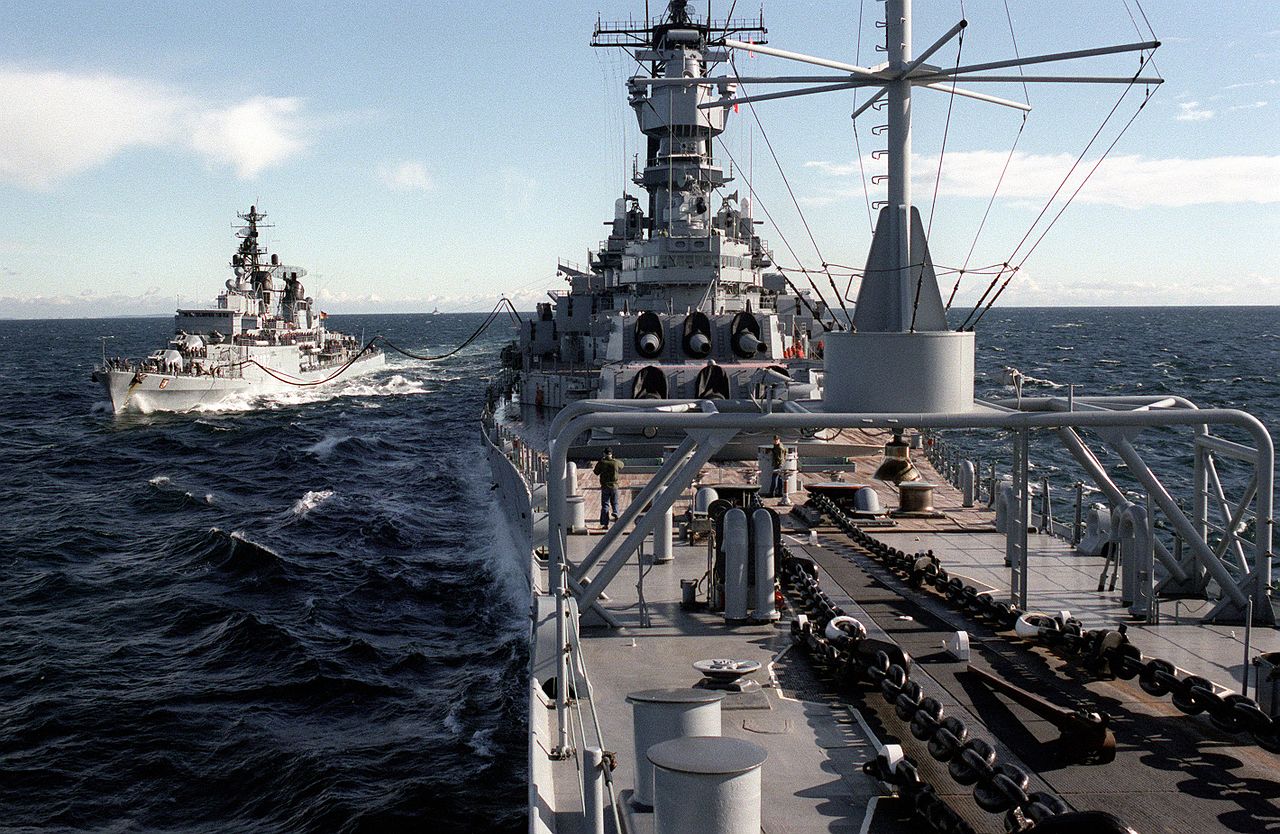 Schleswig-Holstein (D-182) of the hamburg class Type 101 DDs refuelled at sea by USS Iowa
Schleswig-Holstein (D-182) of the hamburg class Type 101 DDs refuelled at sea by USS Iowa
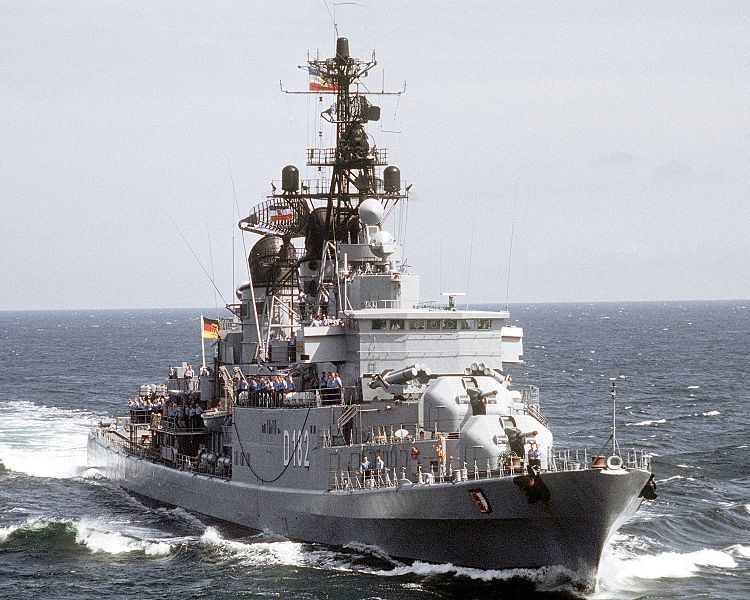
Schleswig-Holstein of the Hamburg class destroyers
The 1960-70s Bundesmarine
The renaissance of German naval industry
With the war, all major shipyards and facilities has been comprehensively destroyed, either by allied bombings, or willfull sabotage and destructions by orders of Hitler himself in 1945 in his radical “scorched earth” policy. In short, there was no industry capable of undertaking the building of domestic ships for years, at least until the mid-1950s for small ships, and gradually the industrial network was renewed, with as main objective, to secure the building of a commercial fleet, before any military venture.
However in 1953 already, the reputed yard of Lürssen werft was authorized to launch the Plejad class FACs for the Swedish Navy, in order to sharpen its skills. The yard would delivered more than fifty other exports and the Jaguar-class for the Bundesmarine. Lürssen designs became extremely successful and many licence were also granted, not counting boats assembly kits and later upgrades.
Another yard that emerged was Abeking & Rassmussen, which provided R-Boats types early on for Indonesia. It was not hard to capitalize on older blueprints, and Brazil received some as well, whereas the Schütze-class minesweepers were delivered for the BDM. This lineage went on with the successful SAR serie, like the SAR-33 for Turkey. A large, old and famous yard that was wrecked by the war will be also rapidly recovered and modernized.
It was the only one with large drydocks and basins able to built and deliver all sizes of warships. They will finance a considerable amount of R&D which will benefit in the end of the BDR with modern Frigates, thanks to the export market. One name stood alone in this: MEKO. These frigates, highly modular, became another tremendous commercial success, with Frigates built Nigeria, Argentina, Turkey and many others.

The very modular design of the MEKO family of frigates helped the German Industry to export far more of these ships than those in service with the BDR: Whereas 56 has been built (or in completion) for the export Market, only 16 were delivered for the BDR, all after the cold war. The MEKO family started in 1981 and really stepped-up after the end of the cold war. It’s a winning formula à la carte, that has never been surpassed in Europe.
The old Howaldswerke-Deutche Werft from Kiel was also modernized and concentrated rather on the large FS1500 Corvettes, but will also design German submarines, in particular under supervision of Prof. Gabler of the IKL of Lübeck. The 205, 207, 209 and following have all found dozens of customers. Oddly enough, there were limits still imposed on tonnage, that were lifted in 1980s, allowing Germany to built larger models for India (SSK 1500) or the TR 1400/1700 for Argentina.
In the 2010s, proud of this expertise, the yard promoted the image of the “world’s quieter submarine”, using the latest advances in construction also seen on the new generation of SNA/SSBN in the 1990s. Added to this, many smaller yards also produced dozens of patrol boats, mainly for export. This was all due to the well-cultivated image of excellence of German engineering.
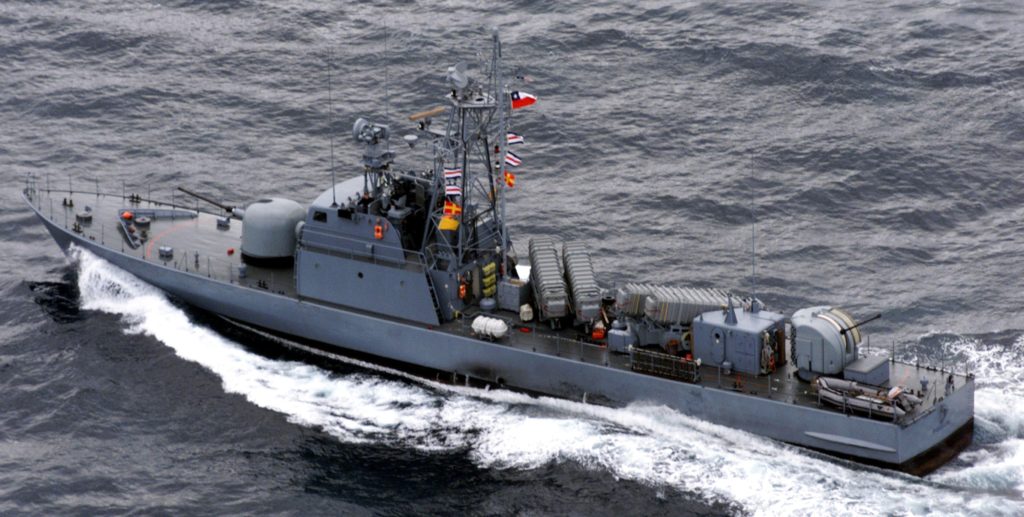
LM-36 FAC
The new cold: 1980s Bundesmarine
From its original integration wihin NATO, The BundesMarine had a mission of coastal defense and Baltic operations and cooperation in sea-control operations in the North Sea. This mission rose to a new level in 1980 when West Germany lifted self-imposed restrictions on naval operations, north of 616 parallel. German control of the western Baltic and its approaches was integrated into the main NATO scheme of naval battles in the North Atlantic, in coordinations with operations in central Europe.
The Warsaw Pact forces coukd stilloutflank allied land forces by attempting a massive amphibious assault in Germany and split their advancing forces in two and capture main NATO Danish and German air bases. They can also close the Denmark strait and secure the Baltic to ensure the success of the Soviet North Fleet with an isolated and virtuallt surrounded Germany.
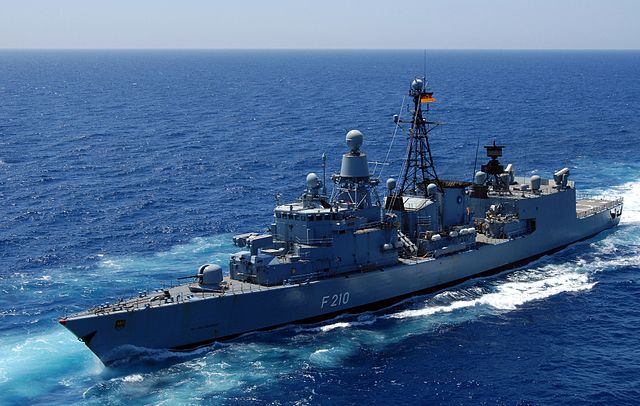
FGS Emden of the Bremen class
In accordance to the Protocol III of the October 1954 Paris Agreements, combat surface vessels over 3,000 tons and submarines of over 350 tons were forbidden, as well as any class of fighting ships nuclear-propelled. However there was the exception of 8 antimissile destroyers of 6,000 tons each and 6 submarines of about 1,000 tons. For these indeed these restrictions were lifted, tonnage granted for destroyers authorized up to 6,000 tons, and more than 1000 for submarines to authorize the purchase. In 1980, revising the Paris Agreements was an ongoing process, as in September 1973 already submarines were authorized with a tonnage of 1,800 tons.
But the last barrier fell when in July 1980, all limitations were lifted altogether.
The Bundesmarine then started to rebuilt the will and capabilities to better secure control of the Baltic. In the 1980s, despite budget constraints they claimed this capability trhough a new generation of ships and structure.
To control the Norwegian waterways a German mission was created, but associated with NATO’s blue water navies, to assert naval superiority, protect reinforcement and supplies, as well as ASW and mine warfare. The German Navy developed and maintained for this area a mixed force of destroyers and frigates, submarines, plus long range maritime patrol aircraft and auxiliary ships to ensure the German North Sea SLOC terminals remained open. Strategy for this area was dependent on other European navies and the USN carrier battle group (CVBG) operations.
In 1980 the new commander of the Bundesmarine Vice Admiral A. Betge announced new plans for the Bundesmarine that “should be ready for such a development of events which would force the Western industrial nations to ensure an organized naval presence in those areas which ordinarily are not included in the sphere of operations of NATO.
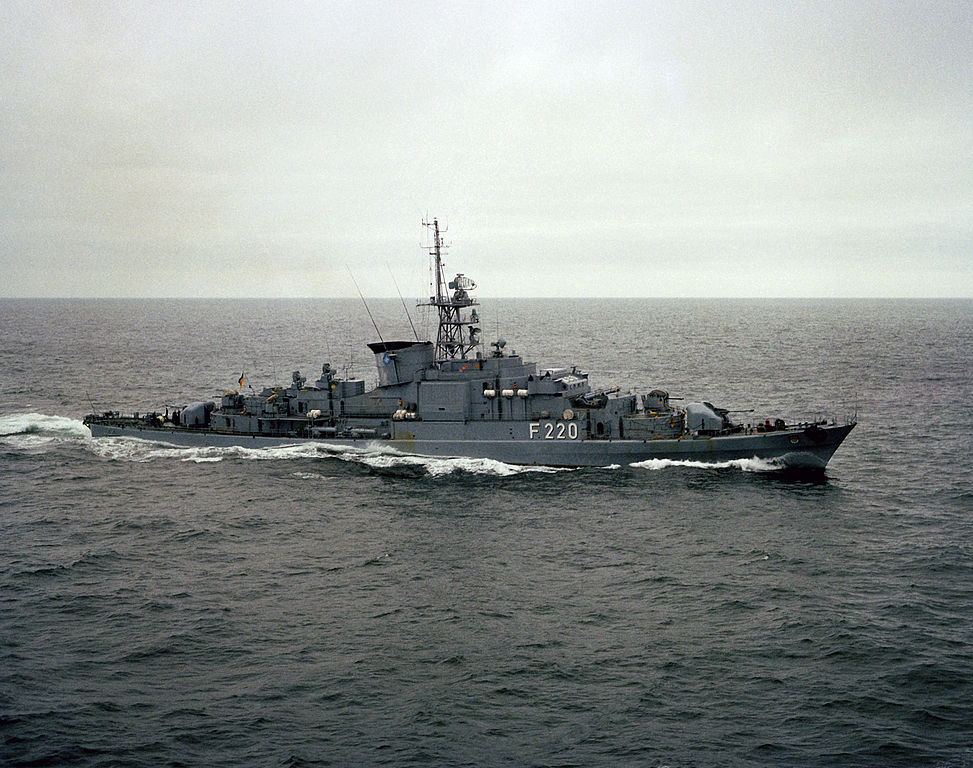
Köln (F-220) underway in 1982
By 1980 at least 10 destroyers and frigates needed replacement and therefore the construction of six Bremen-class frigates with an option for two more was started. German FACs also needed upgrades, as the 40 in service dated back from the 1960s. Therefore 10 Type-143A vessels were started in 1980.
The submarine force comprised 25 U-boats through the construction of the Type-210 submarine also needed replacement. The 18 coastal minesweepers were updated, converted as minehunters and control ships for “Troika” drone minesweepers. There was no minelaying force however, as it was seen as aggressive.
The two squadrons of F-104 fighter bombers were aptly replaced by Tornados, while the North Atlantic maritime patrol aircraft park underwent comprehensive modernization of their weaponry and sensors. With the Soviet invasion of Afghanistan the Bundesmarine took a greater part in the Norwegian Sea operations. But it was clear to anyone at NATO that the commitment of three US CVBGs were critical for this area.
Because of USN redeployments (notably in the Mediterranean) a critical delaying role was to be played by European navies, waiting for reinforcements notably through minelaying actions. The Bundesmarine played her role in this expansionist naval policy, but by weakening her Baltic commitment.
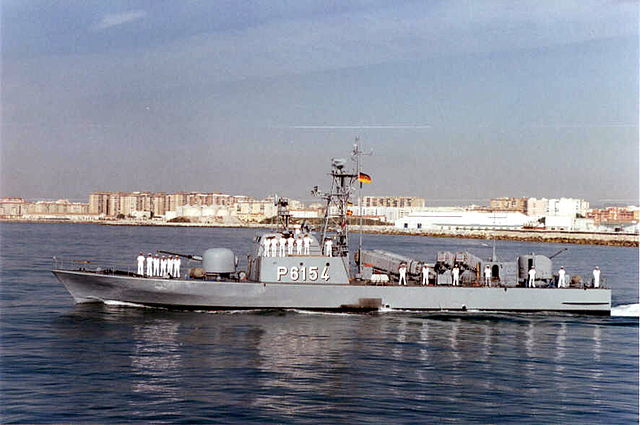
Tiger class Elster FAC (P6154).
Movie of a 1980s German submarine – By Periscope films
The Marineflieger
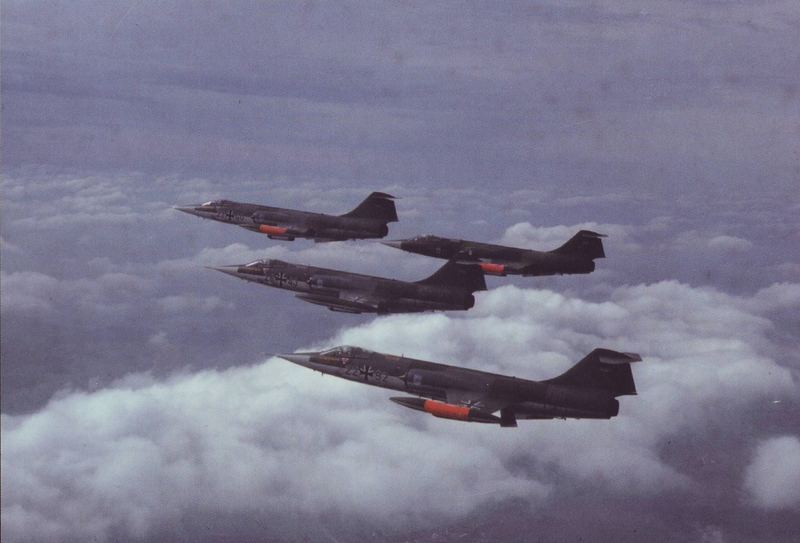
Marineflieger’s F104G in formation. They can carry and operate the Exocet missile.
The Marineflieger is the naval air arm of the Bundesmarine. while during ww1 it was part of the Kaiserliche Marine, the interwar Seeflieger was absorbed by the Luftwaffe in 1935. The abandon of the Graf Zeppelin and reluctance of the Luftwaffe over the matter eventually made the Seeflieger redundant and eliminated in 1943. Anti-ship warfare missions were now all transferred to the Luftwaffe.
From 1955 within NATO and the creation of the Bundesmarine, the Marineflieger was created under some preventions but recoignizing the need of a dedicated air cover, in particular over long range areas in the context of a possible attack in the baltic or from the Northern fleet off Norway.
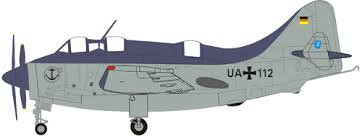
A Fairey Gannet in service with the Bundesmarine
The Marineflieger Command was responsible for five squadrons, operating nearly 200 aircraft and helicopters. This comprised a force of 121 fighter bombers (of the F104G Starfighter type) but also British-buuilt Hawker Sea Hawks Mk100/101s, and from 1980 the Panavia Tornado. Helicopters were of the Saunders Roe Skeeter and Bristol 171 Sycamore 52 at first, and later the Sikorsky H-34G, Westland Mk41 Sea King and Westland Mk88 Sea Lynx used for SAR and ASW missions.
SAR missions however were mostly performed by the Grumman HU-16 Albatross. Martime Patrols, depending of the range required, could be performed either by the Fairey Gannet AS Mk4, the Dassault-Breguet BR1150 Atlantique, or the Lockheed P-3 Orion. The Transport branch took delivery of the locally-built Dornier Do-27, Hunting Percival Pembroke C. 54, Dornier Do-28 D2 Skyservant and Dornier Do-228 LM aircraft.
Special Forces: Kommando Spezialkräfte Marine
Thes are the dedicated Naval Special Forces Command, or Kampfschwimmer (“Combat Swimmers”), with a unit called Verwendungsgruppe 3402, the only dedicated elite special forces unit of the Germany Navy. These are Marine Commandos specialized in amphibious warfare operations, historically set up as joining NATO in 1955. The GDR (East Germany)’s Volksmarinehad an equivalent, called the Kampfschwimmerkommando 18 based in Kühlungsborn, later dissolved.
Some inheritance from WW2
During WW2, two of such units were formed, the SS-Jagdkommando Donau, trained by the Italian X-MAS unit (Decima Flottiglia MAS) in the Mediterranean, and Marine Einsatzkommando from the regular Kriegsmarine in the north, never ready for D-Day. If some operated the German Neger craft (human torpedoes) without success initially, they were mostly used afterwards to blow up bridges on various rivers during the allied progression, both east and west. In the Mediterranean and Adriatic especially, the SS-Jagdkommando Donau operated the “lentil”, a fast silent boat carrying 300 kg of explosive and inspired directly by the Italian MAT, and the “chariot” loosely copied from the maiale. For both units, the largest operations planned were to blow-up the allied pipeline PLUTO and in the Med, block the Suez canal.
The KSM creation and evolution in the cold war
Kampfschwimmers were created to focus on securing the Baltic Sea exists through the Skagerrak, and trained at first with the French Nageurs de Combat operating in Indochina. But like the latter they soon added the 3rd dimension to their skills: Airborne operations. From 1 April 1964, the Kampfschwimmer became fully independent and extended their tasks but were plagued by underfunded procurement. From 1974 Kampfschwimmer were based in Eckernförde, near Kiel.
Post cold-war Reforms
By the time of the Gulf War, they took part in several classified operations, and the staff after the end of the cold war went from about 30,000 to just 3,500.
German naval commandos also performed missions during the NATO arms embargo against former Yugoslavia, boarding suspicious freighters. Also in October 1994, they passed under command of the Flotilla of Mine Warfare. Eckernförde saw the creation of a mine clearance diver company plus a commando frogmen company, with 250 men for the first, and for the second three groups of 16 men each, 40 actively operational.
In 2001 was created the Waffentauchergruppe or “Armed Diver Group”, and later the Bataillon Spezialisierter Kräfte (“Specialised Forces Battalion”), and by 2003 the Spezialisierte Einsatzkräfte Marine or “Specialised Task Forces of the Navy” (SEK M) divided into a Combat Swimmer, mine clearance, and two naval companies to board ships, inspection, with support. On land, they can operate dedicated vehicles also, the 4×4 MOWAG Eagle V, Austrian Enduro KTM 640 LS-E and at sea the folding kayak Wayland MkI 450 Commando.
1990: Integrating the East German Navy

The Sassnitz class FACs were the most modern vessels built in East Germany by October 1990. Three were sold to Poland and the rest were BU on slip after being hulked. Only one was retained: The lead ship Sassnitz, used as a border Guard vessels from 10.1991, still in service in 2019.
The reunification process followed the fall of the Berlin wall on 3 October 1990, and if at first there was a considerable influx of eastern Germans at first to the West, transition to a modern capitalist economy was not always a smooth affair, leaving many (mostly older) populations remaining in East Germany in somewhat great distress to adapt. The cost was supported by Bonn without much issue on the long run, however the question of the inheritance of the Volksarmee and its air and naval components became a headache. Since the Soviet threat was no longer present, with the full dissolution of USSR later solving this issue, troops were demobilized or reintegrated if willing to, the Bundesarmee. They had to retrain for years, on new equipments and standards, not speking of vehicles. The whole park of Soviet-built tanks and AFVs was basically either standardized when possible to NATO standards (like BMPs), or sold outright, notably to former eastern European countries.
Same was done with aviation, and the Navy. For the latter, the issue was to deal with a fleet which also performed duties of securing the eastern baltic coast, tasks that the Bundesmarine could take on without much problem but a reorganization that would take some years to complete (notably new bases to standardize). In between, there was a large panels of ships in any specialization that were to Warsaw Pact standards, with Soviet weaponry, electronics, sensors, and communication, none of which were compatible to NATO standards. They became no longer operational assets, and the question of the Bundesmarine personal was debatable.
In 1990 the former Volksmarine navy personel amounted to 12,300 men, with 4,700 active at sea, 4,100 in coastal defence, the rest in support. There were also 1,000 in the naval air component. Several bases supported this fleet, between Peenemünde, Warnemünde and Dranske-Bug, plus auxiliary bases at Sassnitz, Wolgast and Tarnewitz. Naval aviation was between Parow, Peenemünde and Laage and its assets consisted mainly of helicopters: 20x Mi-8 “Hip”, 8x Mi-14 “Haze”, plus 20 Su-22 “Fiter” fighter-bombers. The “Hip” were rugged, excellent models that were kept quite for a long time before being resold mainly to private operators, but the rest were either refurbished if possible (depending of their general state and possible lack of maintenance) before being resold, under particular circumstances.
The process was an administrative nightmare due to some constitution-based restrictions. There was also a Marine Infantry component and even an elite combat diver unit: Based in Prora, Rügen Island it consisted by 1990 of 1,250 men, the 28th Motorised Rifle Regiment, part of the 8th Motorised Rifle Division.
The Volksmarine was dissolved on 2 October 1990, a day before the official reunification. Only a fraction of the staff was absorbed into the Bundesmarine’s won, while the Navy was renamed the “Deutsche Marine”. A large part of the personal went to the German Border Police. All these ships were not to Western standard and their integration into NATO’s scheme and structure were problematic. All the ships and associated equipment were either scrapped or sold in a few years.
In fact a very few if any former Volksmarine vessels remain in service in the late 1990s and early 2000s. The last commander of the Volksmarine was Vizeadmiral Hendrik Born, which contributed to a commemorative book by historians Dieter Flohr and Peter Seemann published in 2009 “Die Volksmarine”, a comprehensive, illustrated history.
Since the bulk of the Volksmarine (the Naval component of the GDR Army) was entirely created with Warsaw Pact standards and Soviet equipment, West Germany had somethwat either to integrate, discard or resell the following equipments:
-3 Koni class Frigates
-16 Parchim class corvettes
-5 Tarantul class corvettes
-circa 30 FACs (missiles+torp)
-50 Minesweepers/minelayers
-32 landing ships & crafts
The Koni class were of Soviet design, soviet-built Project 1159 ASW frigates, relatively recent but absolutely not of NATO standards. In these cases, the generall opinion was to compare the cost of a reconfiguration standard to their possible value as assets in the Bundesmarine. It was almost always a big no-no. Nerpa (1977) or Rostock was scrapped after 1990, Krechet (1978) or Berlin had the same fate, as SKR-149 (1984) commissioned as Halle also.
The Parchim class corvettes were more complicated, since they were even more recent and of German construction and design. In fact some were exported to USSR. Still, they were on Warsaw Pact standards, with Soviet armaments and sensors, but more recent than the Koni type Frigates. Of 16 ships built, Prenzlau, Ribnitz, Waren, Angermünde, Lübz, Bad Doberan, Wismar, Parchim, Perleberg, Bützow, Bergen, Güstrow, Teterow, Ludwiglust, Grevesmühlen, Gadebusch were in German hands. A quick study was done to see a possible conversion to NATO standards, but the list of modifications was such it was juged not the worth the cost. So the entire parchim class was soon placed on the international market “as is”, and found Indonesia as customer: They became the Lambung Mangkurat class. All the rest were disposed of, given or sold to civilian companies and military alike. Its bulk went to Indonesia which was probably the largest naval contract of the decade, with thirty-nine ships sold total to Indonesia for US$ 314m.
-The Tarantul class was also too costly to standardize, and the Albin Kobis, Rudolf Egelhoffer, Fritz Gobig, Paul Eisenchneider, Hans Baimler were simply discarded, with the exception of Hiddensee (ex-Rudolf Eglhofer), which became a museum ship in Fall River, U.S.A. after being stricken in 1991. All the others were in october 1990.
-The large FAC fleet of East Germany was also a problem to consider: Older torpedo-equipped FACs were sold for BU (Like the Iltis and Hydra class). As for missile boats, the 1960s OSA-I type Max Reichpietsch class FAC(M) were all sold for BU, but the “BALCOM 10” type were quite a recent design in Germany (1990). The Sassnitz class arrived too late: Only two had been delivered before the end of the GDR, one was BU, three were exported to Poland and three more cancelled, at Wolgast, Pennewerft. They were hulked and scrapped in 2010. The only one retained operational was refitted in 1993 with her central shaft removed, two MTU 12V595 TE90 diesels installed, and new armament and sensors (40mm/70 Bofors 315, 2x Decca AC2690BT radars) and two 7.6mm/90 MGs installed in 1997. She is the exception.
-Among amphibious ships, the entire Frosch class LSTs (1976) was also resold to Indonesia. The Labo class LSCs (1960) were all discarded.
-The former Volksmarine also had a consistent fleet of sub-chasers in the 1960s notably those of the “Hai” type in large numbers, of German design. They had been discarded in the 1980s. They would have incompatible with the Deutsche Marine’s doctrine and again, not cheap to standardize.
-Ammong patrol crafts, only the G-23 patrol boats (1971-1972) were recent enough for at least taking some patrol and police duties. But they were all discarded in 1990. Only G20 (Prignitz), G21 (Altmark), G34 (Uckermark), G35 (Börde) were used for a short time.
In the end, the Deutsche Marine retained only 15 combat ships, 15 auxiliaries, standardized to the minimum (mostly communication), and incorporated into the Bundesmarine, with their original systems, but for a short time.
See also On jstor.org – The German Navy after the Cold War and Reunification by Jürgen Ehle (Naval War College Review)
Nomenclature of Bundesmarine ships
The “cruiser” Deutschland (1960)
 Deutschland (1960)
Deutschland (1960)

Flagship and Ambassador of the Bundesmarine for most of the cold war, A59 Deutschland was a large schoolship (A for “auxiliary” in NATO classification), charged to train recruits of the new, rapidly expanding Bundesmarine to the latest weaponry and electronics standard. They trained those who served on the Lütjens and Hamburg class destroyers, Köln and later Bremen class frigates. Although officially a Frigate, she was so large as to be considered a “cruiser”, still vividly remembered by its crews and trainees.
Bundsmarine’s conventional and Missile Destroyers
 ‘Zestörer’ class destroyers (1958-70s)
‘Zestörer’ class destroyers (1958-70s)
Zestörer 1 – Zestörer 6
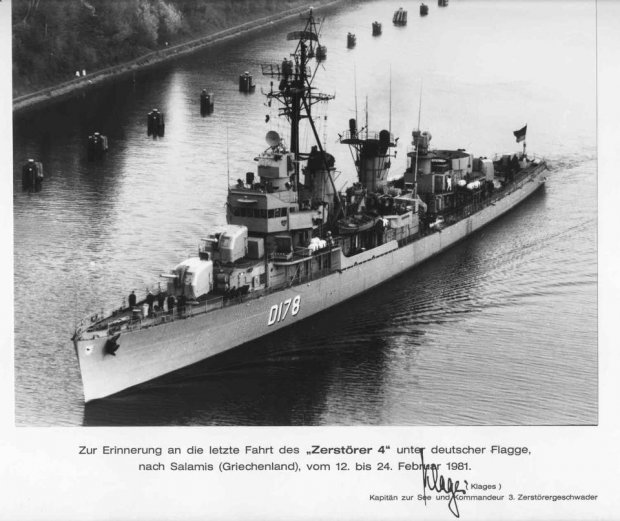
Z4 (D 178) in 1981, through the Kiel canal, on her way to be sold to Greece. The four remaining ships were under leasing but has been bought by the Federal German Navy in 1976.
This was just the name of MDAP program ex-Fletcher class DDs transferred in 1958, 1959 and 1960. Previously the USS Anthony, Rigold, Waldsworth, Claxton, Dyson, and Charles Ausburne. Named “Zestörer 1” to 6 and D170-180, they had been leased for five years and comprehensively modernized: New electronics, and upon arrival, German controls and communication systems. During the late 1960s, their brige structure was modified.
From 1941, Z4 (D 178) was given an OTO-Melara 76mm/62 gun for testings, in a modular container. From 1973 onwards, the quintuple TTs were removed from all ships. D 180 was already sold for BU in 1968, followed by the D170 sunk as target, while the there four were transferred to Greece in 1980-82.
 Hamburg class Destroyers (1959)
Hamburg class Destroyers (1959)
Hamburg, Schleswig-Holstein, Bayern, Hessen
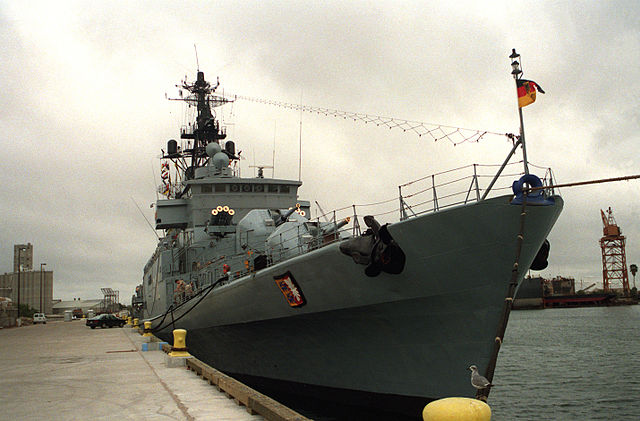
Between the rebuilt and modernized Zerstörer class (1958) and first missile destroyers of the Lütjens class in 1965 the Bundesmarine built conventional destroyers, The Type 101 Hamburg class.
Originally designed as standard gun-armed destroyers they became missile destroyers when added some MM38 Exocet block 1 in 1976-79. They served for three decades, half the cold war, until decommissioned in 1990-94. The design was based on a small flush deck hull and thus “cramped” and overweight. They were based in Wilhelmshaven (Jade, North sea), with the 2. Zerstörergeschwader (second destroyer squadron).

 Lütjens class Missile Destroyers (1965)
Lütjens class Missile Destroyers (1965)
Lütjens, Mölders, Rommel
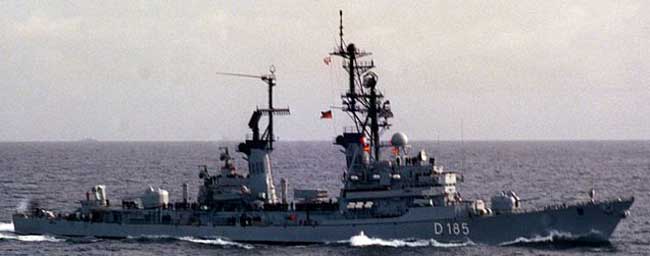
Called the class 103/103A/103B or more commonly Lütjens class, these were the main guided missile destroyers of the Bundesmarine (German Navy). The ships ships were built in 1966-1970 in the United States for the Federal Republic of Germany, based on the the American Charles F. Adams class. This was a sub-class called Mod.14 (Tartar-Guided Missile Destroyers SCB 155). At that time they were 10 years old, within which many defaults and limitations has been ironed out. Lütjens referred to the German Kriegsmarine great admiral Gunther Lütjens, Werner Mölders about a Luftwaffe ace, and Rommel of course referred to the German General of North Africa fame, Erwin Rommel. The destroyers served until the 1990s, assuming the bulk of the Bundesmarine defence during the late cold war era.

 Gneisenau (Type 138) Frigates (1958)
Gneisenau (Type 138) Frigates (1958)
FG 212, 217, 218 Gneisenau, Raule, Brommy
Bundesmarine’s modernized British Hunt Frigates: As part as the rearmament of the newly created Bundesmarine in 1955, as West Germany was now part of NATO, ex stock WW2 allied ships were transferred (purchased with the help of MDAP funds), and among these, a number of British Frigates: Namely three Hunt-class vessels, and four Black swan class vessels (Graf Spee, Scharnhorst, Hipper, Scheer). Despite their short career they were extensively modernized in Germany, and used a bit as floating laboratories for the latest electronic equipments, and superstructures, to the point they probably were the most complete and exhaustive conversions of British frigates during the cold war, ever. But despite of this they only served for ten years.
Note, this post is going to be upadted with Graf Spee (Type 138) and Scharnhorst class (Type 138) under the same. The article mostly deals with the “Raule class” and Gneisenau.
 Köln class Frigates (1961)
Köln class Frigates (1961)
Köln, Emden, Augsburg, Karlsruhe, Lübeck, Braunschweig
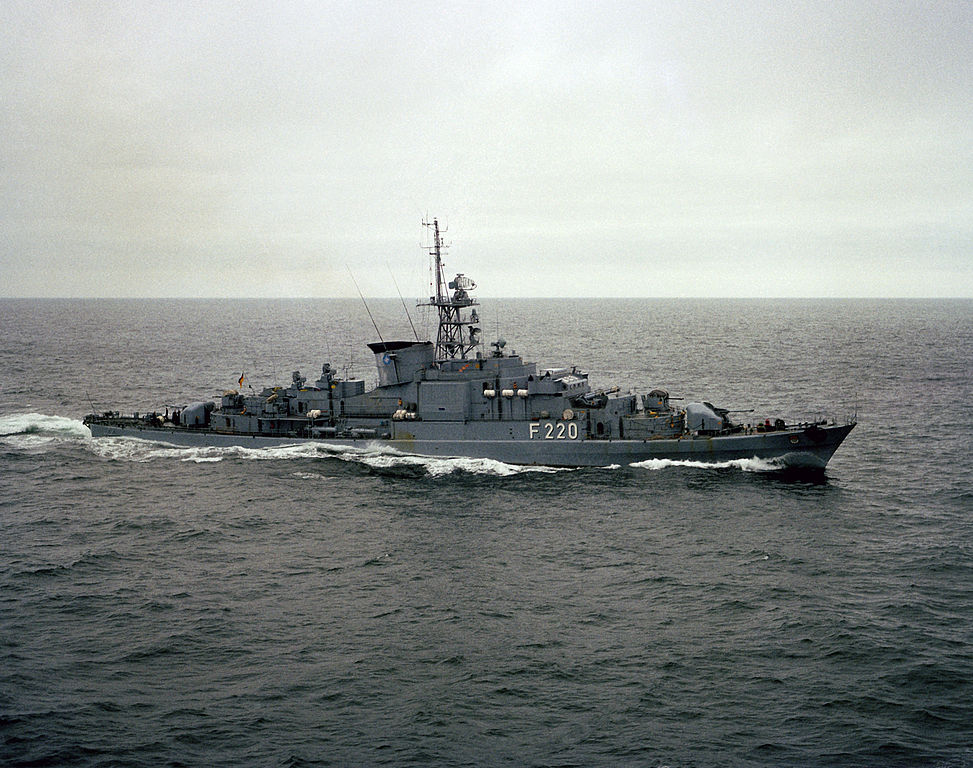
All built in Stülcken, Hamburg, as Type 120 Frigates. Thye were ordered in March 1957, designed in 1955-57 under program ‘Geleitboot 55’ (Escort 55). First German warships to receive CODAG propulsion. Convetional (gun armed) woth an emphasis on ASW capabilities they had refits for increased hull protection and stability plus electronics, with two 533 TT and four short 533 TT (short) removed and in the 1980s, 2 decoy RL. They were all discarded before the end of the cold war in 1982-88, the remainder four sold to Turkey.

Specs: 2090t/2750t standard/FL, 109.8m oa x 11 x 4.60m,, 2 shafts CODAG: 4 MAN V84V24/30 diesels on 2 Brown Boveri TA8007 gas turbines, 38000 shp, 32 kts, 360 tons oil, 3450/12kts radius. Armed with two 100/55 Mle 1953, 2×2 40mm/70 Breda-Bofors 106, 2x 40mm/70 Breda-Bofors 107, 2x 533mm TT, 2×4 375mm Bofors ASWRL, 2x DCR, 82 mines, radars DA-02, SGR-103, Kelvin Hughes 14/9, 2x M44, M45 radars, PAE/CWE sonar, ECM suite. Crew 238
 Bremen class Frigates (1960)
Bremen class Frigates (1960)
Bremen, Niedersachsen, Rheinland-Pfalz, Emden, Köln, Karlsruhe, Augsburg, Lübeck
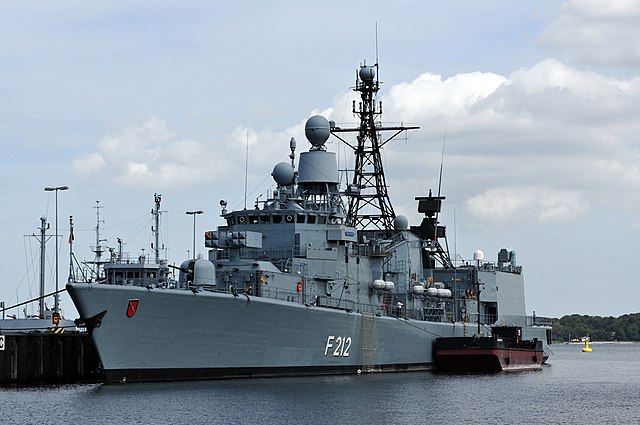
In 1975, the Bundesmarine faced the prospect of the gradual obsolescence of its 1960s ships, and planned a frigate replacement for the Köln class. In fact the design was worked on already in the 1960s, with the experience returns. Previous designs were made quickly under the constraints of the WEU limits, which were lifted when the admiralty looked at the new ships FY1979. The Type 101 and 120 were two well defined designs, escorts ASW/AA role and to repel surface attacks as well as minelaying. But most submarines were diesel-electric when they were first designed, and the air threat was completely different.
With the development of new radar technologies, nuclear submarines, new missiles, better command and control facilities, the new design was to be a 1200 tonnes AA corvette at first, but then new ASW threats forced a return to a 2500 tonnes frigate design. Budget constraints had the Lütjens class adopted for AA escort, and Zobel class vessel modernized instead. Then came the programme ‘Frigate 70’ which development was accepted on 23 January 1969. The Bundestag ratified it as the ‘Frigate 70’ in February. But this was cancelled amidst a design stage showing a 3600 tonnes ship with soaring cost. Design started again on a blank page, looking at foreign designs, notably the Netherland’s standard type (Kortenaer). On 17 July 1975, a memorandum of understanding was signed with the latter, followed by an acceptance by the German defence board in January 1976.
On 26 November 1977, six were ordered as the Type 122 Frigates, and six more would follow in 1986, authorized FY1985 (only two built). Bremer Vulkan Shipyard took the lead of the project, followed by Blohm & Voss, other ships being built at Thyssen-Nordseewerke and AG Weser, HDW in Kiel. Four hulls were laid down in 1979, F207-210 (Bremen, Niedersachsen, Rheinland-Pfalz, Emden) and two more in 1980 and 1981 (F211 Köln, F212 Karlsruhe), followed by batch 2 (F213 Augsburg, F214 Lübeck) in 1987. The remainder were cancelled as international prospects and design evolution in between leaned towards a larger, better design (which eventually became the Brandenburg class, laid down from 1992).
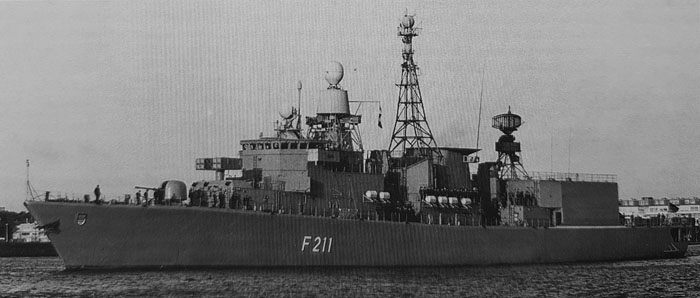
They were equipped with NATO Sea Sparrow with Mk21 launcher (24 in store). It was completed by the US RAM system atop the hangar in 2×24 launchers. For ASW, WG-13 Lynx helicopter with DAQS-13D dissping sonar, Canadian Bear-trap system. This was later completed by eight Harpoon missiles for antiship defence, four Mk.32 TTs, and an OTO Melara 76mm. All ships are currently decommissioned, the very last this year. It started in July 2012 and went on until 2019. Among other deployments, Karlsruhe repelled pirates on 25 December 2008 in the Gulf of Aden Rheinland-Pfalz in 2012 gathered intelligence on Syrian troop movements, and by December 2015 Augsburg joined the FS Charles de Gaulle in the SE Mediterranean Sea to support the intervention against ISIS (Syrian Civil War).

Specs: 3,680 tonnes standard, 130.50 x 14.60 x 6.30 m, CODOG 10,920+51,000+1,010 hp, 30 knots, range 4,000 nmi (7,400 km). Armed with EADS TRS-3D air search radar, WM 25 combined surface search and fire control radar, Thales Nederland STIR 180 fire-control radar, Kelvin Hughes Nucleus 5000 navigation radar, STN Atlas DSQS-23BZ hull-mounted sonar, ESM/ECM EADS FL 1800S, SCLAR decoys, SLQ-25 Nixie torpedo decoy. Armament: OTO-Melara 76 mm, 2× Mauser MLG27 27 mm autocannons, Sea Sparrow 8-cell launch system, MK 49 launcher RAM, 2×4 Harpoon, 2× Mark 32 324-mm TTs, 2 Sea Lynx Mk.88A with torpedoes, Sea Skua missiles, buoys and dipping sonar.
 Brandenburg class Frigates (1995)
Brandenburg class Frigates (1995)
Brandenburg, Schleswig-Holstein, Bayern, Mecklenburg-Vorpommern
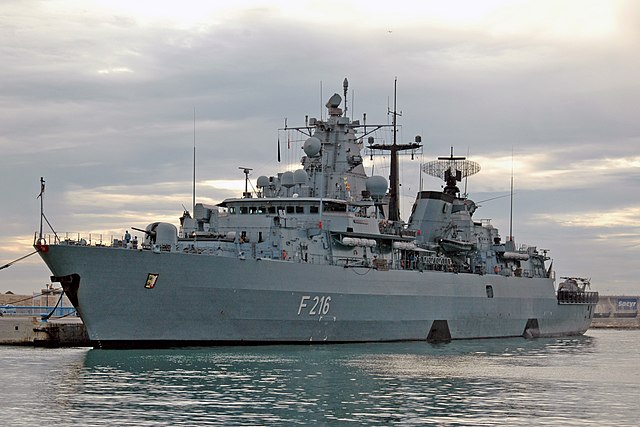
Schleswig-Holstein (F216) in September 2010
Although a bit off-topic since the lead ship was completed well after the end of the cold war, the Brandenburg class frigates were planned and studied in the 1980s, as the last Bremen class were entering service. They were succeeded themselves by the derived Sachsen class (Sachsen, Hamburg, Hessen launched 2001-2003) and the actual Baden-Württemberg class (Baden-Württemberg, Nordrhein-Westfalen, Sachsen-Anhalt, Rheinland-Pfalz 2013-2017), very different.
The Type F123 frigates were ordered by the German Navy in June 1989, the mlast being commissioned in 1996 to replace the 1960s Hamburg-class destroyers. They were mostly tailored for ASW warfare, with a residual anti-aircraft role, but also geared towards tactical command and though for surface-to-surface operations. The next Sachsen were suppose to replace the first batch of Bremen class.
In 1985 replacement for the Hamburg class, completely obsolete, was overdue. Blohm + Voss was contracted to create these ships from a clean-sheet design in 1989, unlike the Bremen class, closely derivated from the Dutch Kortenaer. Bremer Vulkan on its side proposed a new modernized version of the Bremen, but the proposal was not retained. Blohm + Voss and Bremer Vulkan presented the F123 as a joint programme, with some controversy.
The new class was about the same size as the Bremen, a bit lighter despite being longer, and with more beam. Wholesale automatisation made the crew drop slightly, but not as much as in following classes. The hull design was slanted and recalled a bit the MEKO class frigates built in the meantime for export. The design was said to incorporate some early stealthy measures, but not at the scale of the French Lafayette class.

Specs: 3,600 tons standard, 4,490t full load, 138.85 x 16.7 x 6.3m (455.5 x 55 x 14.3 ft). Propulsion CODOG with two MTU 20V 956 TB92 diesels (8.14 MW each), two GE LM2500 gas turbines (38 MW total) mated on two Renk BGS 178 Lo gearboxes. Top speed 29 knots, range 4,000 nm, crew 26+193. Radars: Thales LW08, SMART-S, STIR 180 FCS, Raytheon Redpath I, STN Atlas DSQS-23BZ hull-mounted sonar, EADS FL 1800S ECM suite, 4x TKWA/MASS decoy dispensers. Armament: OTO-Melara 76 mm/62 Mk-75, 2x Mauder BK-27 27 mm, Mk 41 Mod 3 Sea Sparrow, Mk 49 launchers RAM, 2×8 Harpoon SSM (later MM38 Exocet), 2×3 324 mm Mk 46 TTs, 2 Sea Lynx helicopters.
 Type 201 class submarines (1960)
Type 201 class submarines (1960)

The development of Bundesmarine’s Submarine Fleet only took shape after refloating a sunken Type XXIII U-Boat, which became “U Hai” in 1957, and “U Hecht” (U 2367), and then a Type XXI, “Hu Wal”, former U 2540. With regained experience and under NATO’s blessing, the Bundesmarine worked on its first postwar design, the Type 201 ordered on March 16, 1959 for twelve boats. But being the first, they accumulated problems, notably with the hull integrity, due to a procurement affair which became the “steel crisis”. All four boats (U-1 to U-4) launched 1961-63 had serious problems and were ultimately rebuilt. This led to the new Type 205, a last a success (and also en export success).
 Type 205 class submarines (1962)
Type 205 class submarines (1962)

The Type 205 was a complete revision of the Type 201, with a better hull and perfected design in general. The serie restarted at U-1, with twelve built as initially planned, launched 1967-69. All were built at Howaldtswerke, Kiel, followed by two ordered by Denmark and built by Copenhagen Naval Dockyard (Kobben class).
Specs: 419/455 t surfaced/submerged, 44.30 x 4.59 x 3.8 m (145.3 ft x 15 ft 1 in x 12 ft 6 in), Prop. 2× 440 kW (590 hp) Mercedes-Benz 4-stroke V12 diesels + BBC generator 1,100 kW (1,500 hp) SSW electric motor: 10/17 kts surf/submerged, Range 3,950 nmi/4 kts surfaced, 228 nmi sub. Test depth 100 m (330 ft), Crew 4+18, armed with 8 × 533 mm (21 in) torpedo tubes.
 Type 206 class submarines (1971)
Type 206 class submarines (1971)
S-192-199 and S170-179

The Type 206 were an incremental development of the Type 205, more silent diesel-electric submarines designed and built at Howaldtswerke-Deutsche Werft, a bit longer yet still small and agile to operate in the shallow Baltic Sea and having new pressure hulls built out of non-magnetic steel to defeat magnetic naval mines and avoid MAD type sensors detection difficult. For the first time, this acoustic and magnetic stealth allowed them to operate even into Soviet carrier formations and fleets. The serie comprised 18 U-Boats, laid down 1969-1971, completed 1973-79. Eight were sold to Columbia and Indonesia, the rest scrapped or in long term reserve. A sub-version became the Israeli Gal class.
Specs: 456/500 t surfaced/submerged, 48.50 x 4.58 x 4.3 m, Prop. 2x MTU 12V 493 diesels with Asea Brown Boveri-generator, Siemens-Schuckert-Werke electric motor, 4/5-blade propeller: 10/17 kts surf/submerged, Range 4,500 nmi/4 kts surfaced, 228 nmi sub. Test depth 200 m, Crew 4+18, armed with 8 × 533 mm (21 in) torpedo tubes & mines.
 Type 209 class submarines (1973)
Type 209 class submarines (1973)
Arg. Salta class, Brazil Tupi class, Chile Thomson class, Columbia Pijao class, Ecuador Shyri class, Egypt Type 209/1400mod, Greek Glavkos & Poseidon class, India Shishumar class, Indonesia Cakra/Nagapasa class, ROCS Chang Bogo class, Peru Islay class, South Africa Heroine class, Turkey Preveze/Gür/Atılay-class, Venezuela Sabalo class

Tikuna, Brazilian Tupi class, modified Type 209/1400.
The Type 209 was an evolution of the type 206 developed exclusively for export, by HDW. It became the largest export run of anu European submarine ever. The first Type 209/1100 was designed from 1968 and declined into four other variants (209/1200, 209/1300, 209/1400 and 209/1500) sold to 13 countries, 61 submarines in all between 1971 and 2008.
Specs: 456/500 t surfaced/submerged, 48.50 x 4.58 x 4.3 m, Prop. 2x MTU 12V 493 diesels with Asea Brown Boveri-generator, Siemens-Schuckert-Werke electric motor, 4/5-blade propeller: 10/17 kts surf/submerged, Range 4,500 nmi/4 kts surfaced, 228 nmi sub. Test depth 200 m, Crew 4+18, armed with 8 × 533 mm (21 in) torpedo tubes & mines.
 Thetis class corvettes (1960)
Thetis class corvettes (1960)
Thetis, Hermes, Najad, Triton, Theseus

Originally, these Class 420 type boats were tailored vessel to to recover practice torpedoes, becoming general-purpose craft at the weapons school’s training units. Thetis was the heaf of a class of four built by Rolandwerft, Bremen. The first was laid down in 1960, launched 5 August 1961, operational by 10 November 1962. The next decade saw them all modified as coastal submarine hunters fitted with ELAC 1 BV sonar plus quadrupl Bofors 375mm ASWRL on foredeck, twin 40mm Bofors aft, original twin torpedo tubes modernized to fire wire-guided missiles. The original crane was also removed as the torpedo recovery gear. Before being reslod to Greece in 1992-94 they received new 324mm torpedoes.

Specs: Displacement 599t/732t, 69.8 x 8.2 x 4.2, 2-shaft diesels delivering 6000bhp, 24 kts, Range 2,750 nm (5,100 km) crew 68, see notes.
Note: There was an additional Corvette built by Atlas-Werke, Bremen, to perform the same role as torpedo recovery vessel, Hans Burkner (pennant Y879). She was the sixth “Large B Type” boat with a new design, larger, launched in 1961 and commissioned in May 1963, but was turned to the Trials Command as A 1449 with a reduced civilian crew. She became a trials ships for AZW equipments, decommissioned in 1990. It should be noted that the Bundermarine also obtained two Le Fougueux class Vessels (Part of a NATO order to France, bult in Fubigeon Yards Nantes), UW 12 (comm. BdM March 1957) – training boat for the underwater weapons school, and later to Tunisia while P 1616 was not commissioned and instead was resold to Ethopia, but went back to the USN and was lent to Italy.
Specs: 983/1347 tons, 81 x 9.4 x 2.8m (265 x 30 x 9 ft). 2 shafts MAN diesels 13,600 bhp, 24 kts, range 2,180 nm. Armament 2x 40mm Bofors, 1x 375 mm ASWRL, 2x 533mm ASW TTs.
 Type 149 Silbermöwe class FACs (1960)
Type 149 Silbermöwe class FACs (1960)
Silbermöwe, Sturmmöwe, Wildschwan, Eismöwe, Raubmöwe, Seeschwalbe (P 6052-6057)
Basically modernized S-Boats from WW2. The design was the same, and caracteristics very close. They were called the Type 149, the first Bundesmarine’s cold war FACs, in addition to older S-Boote inherited from the numerous ww2 fleet. Following the postdam conference however they were restrictions on 40+ kts boats for Germany and first three ordered in 1952 to Lürssen, Vegesack were assigned to the frontier guard.
Even though, construction was stopped by British occupation authorities in 1953. It was greenlighted again, this time for the guise of the Royal Navy. By May 1955, the Military Security Department gave the authorization for three more. The first, launched in 1954-55 served with German crews but British officers and the next three were pressed into the Bundesmarine, then all. The very last was commissioned on 23 April 1957. By 1968 the first five were resold to the Greek Navy, the last became the TS UW9 in 1960 and was rebuilt in 1964 as the trials boat Y 839 Wilhalm Laudahn with new engines and a civilian crew, undergoing seveeral reconstructions during her long career afterwards (fate unknown).
Specs: Displacement 190t standard/155 t FK, 35.6 oa x 5.20 x 1.60m, 3 shafts Mercedes-Benz diesels (P6057 Maybach), 9000 shp, 42 kts, 13t oil, 900nm/34 kts). Armed with two 20mm/80 Mk 7 (HS804) (P6057 one 40mm/70 Bofors 350) and two 21-in (533mm) TTs. Navigation radar, crew 19.
 Type 140 Jaguar class FACs (1960)
Type 140 Jaguar class FACs (1960)
Jaguar, Iltis, Wolf, Luchs, Leopard, Löwe, Fuchs, Marder, Weihe, Kranich, Storch, Häher, Elster, Reiher, Dommel, Pinguin, Tiger, Panther, Alk, Pelikan

The Type 140 Jaguar-class fast attack craft was developed by Lürssen under the internal designation Schnellboot 55, as an improvement of the Type 149 and new take on the WW2 S-Boote design. In all, 20 were built for the Bundesmarine, commissioned from 1957-60 and in service until to 1975, replaced by the Tiger class missile FACs. The Jaguar-class were optimised for high sea action, larger than S-Boats, capable of 43 kts and more with a longer range. The NATO assignation was to intercept (Soviet) landing operations in the Baltic Sea, but also transfers of ships from Soviet Union, disrupt communications and protect the final leg of transatlantic supply lines in the North Sea. The Seeadler sub-class had Maybach engines instead and other specifics (in brackets below).
After a relatively short service they were nearly all resold to Greece and Turkey.
Specs: Displacement 184(195)t/210(221)t FL. 42.6(39.8 wl) x 7.10 x 2.30(2.40), 4 shafts Mercedes-Benz diesels, 14,400 hp 43 kts, 1,000 nm/32 kts. Armed with two 20mm/70 Mk 7 and 4x 21-in (533mm) TTs. Or 2x 40mm/70 Bofors 350, same plus mines. Decca 1226 radar, crew 39.
 Hugin/Pfeil FACs (1960)
Hugin/Pfeil FACs (1960)
Hugin, Munin, Pfeil, Strahl
Two semi-experimental vessels built in Norway: P6191 Hugin and P6192 Munin delivered by Westermoen, Mandal. Close to the cold war PT-Boats of the Nasty class. Capable of 45 kts (aluminium hull) they were armed with two 40mm/70 Bofors 350, and four 533mm TT tubes and a Decca 707 radar. After many tests and trials, were resold in 1964 to Turkey as Doğan and Martı. The Pfeil class or Type 153 FACs, P6193 Pfeil and Strahl were obtained from UK, Vosper, to test the Brave and Ferocity class design. They had hard-chine planing, and a CODOG propulsion with 2 Proteus gas turbines with 2 diesels to reach 54 kts, armament was the same as the Hugin class. Both were resold to Greece in 1967.
 Zobel class FACs (1960)
Zobel class FACs (1960)
Zobel, Wiesel, Dachs, Hermelin, Nerz, Puma, Gepard, Hyäne, Frettchen, Ozelot
Experience with the designs above led to the ZOBEL fast attack craft (torpedo) from 1961 to 1963, ten ships built in Lürssen Vegesack and Kröger-Werft, Schacht-Audorf. Internally called “Schnellboote 60” and Type 142 officially. Compared to the Tiger, they had an additional superstructure aft of the bridge which was more streamlined, plus new masts. Ten more were planned but not ordered. As modernizations, some received Seal wire-guided torpedoes and Kelvin Hughes 14mm/9 CIWS plus new radars. They were discarded in 1981-84 after being reassigned to Turkey, but this was cancelled.
Specs: Displacement 173/190t FL, 42.6 x 7.10 x 2.30m, 4 shafts Mercedes-Benz diesels 14,400 shp, 43 kts, Max speed, kts, 1000 nm/32 kts, armed with two 40mm/70 Bofors 350, four 533mm TT or mines, provided with a Decca 1226 radar, crew 39.
 S41 (Tiger) class FACs
S41 (Tiger) class FACs
Tiger, Iltis, Luchs, Marder, Leopard, Fuchs, Jaguar, Löwe, Wolf, Panther, Häher, Storch, Pelikan, Elster, Alk, Dommel, Weihe, Pinguin, Reiher, Kranich
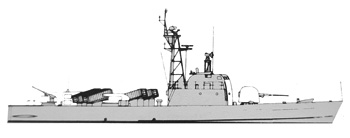
The Type 148 Tiger class Fast Attack Missile Craft wer the first of their kind build for the Bundesmarine. The prototype was French, a La Combattante II type built around the Exocet missile, by Constructions Mécaniques de Normandie (CMN), Cherbourg, France. It was at the origin a German design, as La Combattante IIa camed from Lürssen for Israel, built in CMN for political reasons. The rest of the order were built in Germany by Lürssen. They arrived in the mid-1970s to replace former torpedo-armed Jaguar-class (3rd and 5th Squadrons) and only had numbers, receiving names at the insistance of their crews. They had 30 years of service, after 1982-84 and 1990-92 modernizations and upgrades.
Specs: Disp.: 265 t, Dims. 47 x 7 x 2.7 meters (154 ft 2 in x 23 x 8ft 10 in). Prop.: 4 shafts MTU MD 16V 538 TB90 TD (8800 kW/11800 hp total), 36 knots (67 km/h). Range:
570 nm (1060 km) max, 1,600 /15 kts. Armed with Oto-Melara 76/62 Compact, 4x MM38 Exocet SSM, Bofors 40mm, 8 naval mines. Sensors: SMA3 RM20 Nav Rad, Triton G Surv Rad, CASTOR II FCS, Link 11 com, decoy and flare launcher, ECM. Crew: 30
 S61 class FACs (1975)
S61 class FACs (1975)
Albatros, Falke, Geier, Bussard, Sperber, Greif, Kondor, Seeadler, Habicht, Kormoran
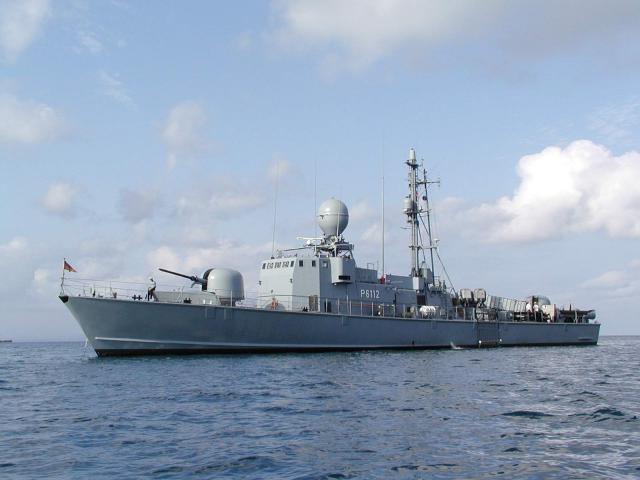
Type 143 Albatros class were missiled FAC (fast attack craft) built by Lürssen and Kröger to replace the Type 141 Seeadler class. They were retired in 2005 (sold to Tunisia and Ghana). Requirements for the design were ready by October 1966, ordered in July 1972, constructed of composite hulls. They served in the 2. and 7. Schnellboot Geschwader based in Warnemünde.
Specs: Disp. 404 t, 57.80 x 7.8 x 2.6 m (189 ft 8 in x 25 ft 7 in x 8 ft 6 in). Prop. 4 shafts MTU 16V 956 TB91 diesels 17,700 hp (13.2 MW), 40 knots. Range 1,300 nmi/30kts. Crew 40. Armed with 2× OTO-Melara 76 mm guns, 4 × MM38 SSM, 2 × 533 mm (21 in) TTs. Sensors SMA 3 RM 20 nav rad, WM27 SFCR, Decoy launcher HOT DOG, Chaff launcher DAG 2200 Wolke
 S71 class FACs (1981)
S71 class FACs (1981)
Gepard, Puma, Hermelin, Nerz, Zobel, Frettchen, Dachs, Ozelot, Wiesel, Hyäne

The Type 143A (Gepard class) were exocet missile armed Schnellboot, last in service with the Bundesmarine. Two were sold to Ghana, the last were retired on 16 November 2016 in German service.They evolved from the Albatros class but with a RAM system instead of a 76mm OTO gun. The much larger Braunschweig-class corvettes replaced them. They served in the 2. and 7. Schnellbootgeschwade in Warnemünde. The end of the cold war made them redundant, the first being retired in 2012.
Specs: 390 t, 57.6 x 7.8 x 2.6 m (189 x 25.7 x 8.6 ft.in). Prop. 4 shaft diesels 13,235 kW (17,748 hp) 40 knots, crew 5+31. Armed with a single Otobreda 76 mm, 4× MM38 SSM, GDC RAM launcher, 2 × MG50-1 MGs. Sensors & ECM, decoys as S61.
 KFK type Patrol Boats (1956)
KFK type Patrol Boats (1956)
KW-1 – KW-10
Former Kriegsmarine Naval Fishing Vessels or KFK built in large serie, design from Maierform GmBh developed as dual purpose vessels, auxiliary ASW patrol boats and for reconnaissance. Three were in the GMSA postwar, repurchased by the Federal Frointier guard, and modified in September 1951 for W13 – W19. They were all repurchased by th Bundesmarine, all but two decommissioned in 1963, playing the role of harbour defence flotilla. Three were repurpose (TS, radio controlle boat) and the rest went to Tanzania and Greek Navy.
Specs: 110-112t 21.5 x 6.4 x 2.7m, 1 shaft Demage diesel 150 bhp 11 kts, 3.4t oil, 1200 nm/7 kts/ One 20mm gun, crew 16.
 Kw 15 class PBs (1960)
Kw 15 class PBs (1960)
KW-15 to KW-20
Built by Lürssen, Schweer and Schürendstedt, commissioned on 30 Nov. 1956, based on a USN design, the Type 369 were relatively fast patrol boats, well armed, and formed vessels of the LSU Weser River Patrol. Eventually reconverted as Type 909 air rescue boats FL-4 to FL-8, comm. at first with the USN in 1852-53 unarmed. Four decomm. in 1964, BG-1 – BG-4 in 1971, disarmed and security vessels with civilian crews for the territorial command, decomm. 1993. KW19 was a dispatch vessel in the North Sea, decomm. 1981.
Specs: 51.6-77.8t, 27/29 x 4.7 x 1.4m, 3 shaft Mercedes Diesels 2000 bhp, 25 kts oil 7t, 2x 20mm, 2×2 40mm AA. Crew 17.
 Neustadt (Bad Bramstedt) class PBs (1960)
Neustadt (Bad Bramstedt) class PBs (1960)
Neustadt, Bad Bramstedt, Uelzen, Duderstadt, Eschwege, Asfeld, Bayreuth, Rosenheim
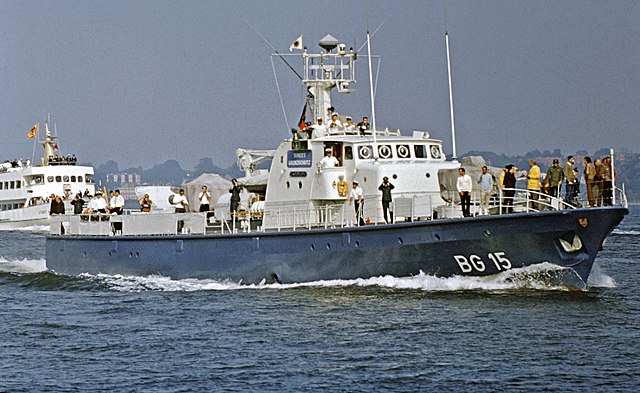
Eschwege in Kiel, 1972
Ships of the Bundesgrenzchütze, federal frontier guard created before the Bundesmarine, launched 1969-70, built by Lürssen, with blue hull and white superstructure. They completed four Type 369 boats, for policing waters, still attached to the Bundesmarine (so they are here). Uelzen sold to Mauretania 1990, the other sold in the 2000s to Bulgaria and Romania in the 1990s. Replaced by a new 2000s Bad Bramstedt class.
Specs 191.4/218t FL, 39.3 x 7 x 2.1m, 3 shafts 2 MTU diesels 685 bhp, 9/30 kts,Oil 15.5t, 450 nm/27 kts. 2x 40mm AA, crew 23.
 Bundesmarine’s amphibious crafts & assault ships
Bundesmarine’s amphibious crafts & assault ships
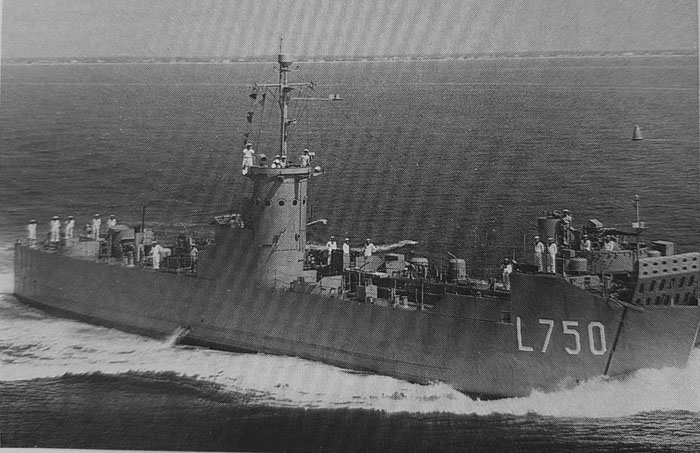
From 1958 to 1970-76 when sold, the Bundesmarine operated four ex-US LSM (Medium Landing Ships): Krokodil, Eidechse, Salamander, Viper. Also, two LSMR type, Otter and Natter also acquired in 1958, sold 1971. The first locally built landing crafts were the Butt class, 22 Utility Landing Craft in all, built at Howaldtstwerke in Hamburg. Impoved versions of the US LCU 1640 class. Launched in 1966 they were decommissioned in the late 1980s. The Bundesmarine also operated 28 LCM type decomm. in the 1990s and a single LST converted as floating HQ LCU-1 from 1959 to 1968.
Chapter in development, completion expected for October, 3.
 Krokodil class LSMs (1958)
Krokodil class LSMs (1958)
 Otter class LSMRs (1958)
Otter class LSMRs (1958)
 Butt class LCUs (1966)
Butt class LCUs (1966)
 Bundesmarine’s LCMs (1958)
Bundesmarine’s LCMs (1958)
 Bundesmarine’s LCTs (1959)
Bundesmarine’s LCTs (1959)
Bundesmarine’s Mine Warfare
Chapter in development, completion expected for October, 3.
 Bamberg class minelayers (1960)
Bamberg class minelayers (1960)
 Sachsenwald class mine transports (1960)
Sachsenwald class mine transports (1960)

 Type 319 minesweepers (1960)
Type 319 minesweepers (1960)
 Lindau class minesweepers (1960)
Lindau class minesweepers (1960)
 Vegesack class minesweepers (1960)
Vegesack class minesweepers (1960)
 Schutze class minesweepers (1960)
Schutze class minesweepers (1960)
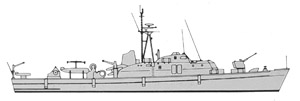
 Bundesmarine R Boote (1960)
Bundesmarine R Boote (1960)
 Hansa inshore Ms. (1960)
Hansa inshore Ms. (1960)
 Ariadne class inshore Ms. (1960)
Ariadne class inshore Ms. (1960)
 Frauenlob class inshore Ms. (1960)
Frauenlob class inshore Ms. (1960)
 Holnis class inshore Ms. (1960)
Holnis class inshore Ms. (1960)
–>
 Hameln class inshore Ms. (1960)
Hameln class inshore Ms. (1960)
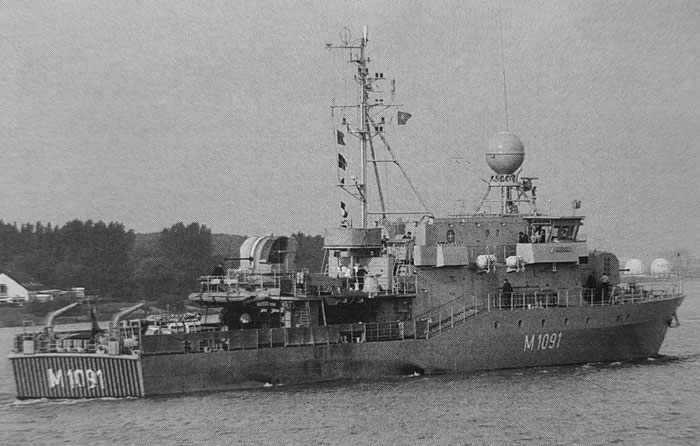

 Frankentahl class inshore Ms. (1960)
Frankentahl class inshore Ms. (1960)
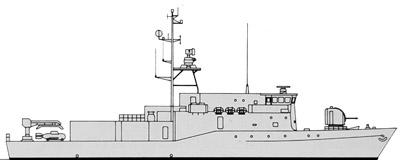
 Rhein class support ships (1960)
Rhein class support ships (1960)

 Mosel class support ships (1960)
Mosel class support ships (1960)
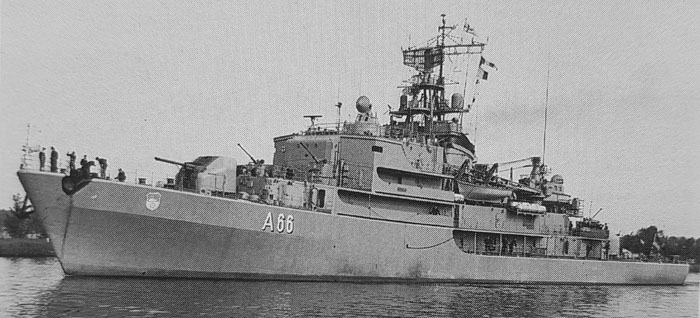
 Lahn class support ships (1960)
Lahn class support ships (1960)
Read More
- https://www.globalsecurity.org/military/world/europe/de-navy-cold-war.htm
- http://www.warpp.info/en/m5/articles/german-submarine-exports
- https://en.wikipedia.org/wiki/German_Navy
- https://en.wikipedia.org/wiki/German_Mine_Sweeping_Administration
- http://coldwardecoded.blogspot.com/2013/06/normal-0-false-false-false-en-us-x-none_29.html
- https://en.wikipedia.org/wiki/List_of_German_Navy_ship_classes


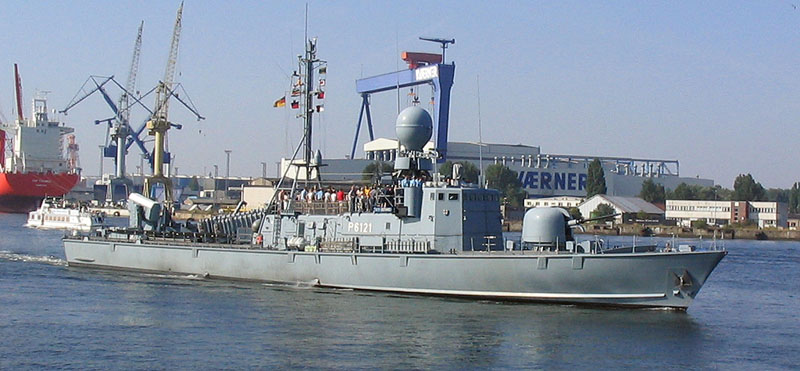
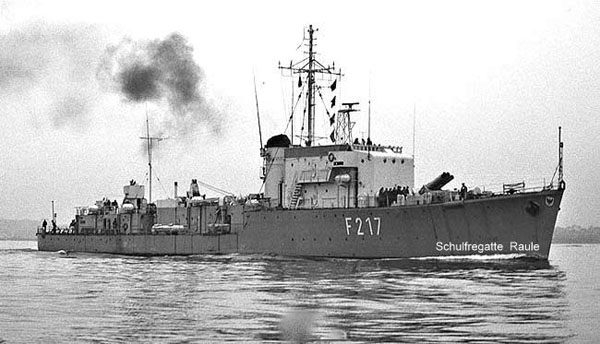
 Latest Facebook Entry -
Latest Facebook Entry -  X(Tweeter) Naval Encyclopedia's deck archive
X(Tweeter) Naval Encyclopedia's deck archive Instagram (@navalencyc)
Instagram (@navalencyc)





 French Navy
French Navy Royal Navy
Royal Navy Russian Navy
Russian Navy Armada Espanola
Armada Espanola Austrian Navy
Austrian Navy K.u.K. Kriegsmarine
K.u.K. Kriegsmarine Dansk Marine
Dansk Marine Nautiko Hellenon
Nautiko Hellenon Koninklije Marine 1870
Koninklije Marine 1870 Marinha do Brasil
Marinha do Brasil Osmanlı Donanması
Osmanlı Donanması Marina Do Peru
Marina Do Peru Marinha do Portugal
Marinha do Portugal Regia Marina 1870
Regia Marina 1870 Nihhon Kaigun 1870
Nihhon Kaigun 1870 Preußische Marine 1870
Preußische Marine 1870 Russkiy Flot 1870
Russkiy Flot 1870 Svenska marinen
Svenska marinen Søværnet
Søværnet Union Navy
Union Navy Confederate Navy
Confederate Navy Armada de Argentina
Armada de Argentina Imperial Chinese Navy
Imperial Chinese Navy Marinha do Portugal
Marinha do Portugal Mexico
Mexico Kaiserliche Marine
Kaiserliche Marine 1898 US Navy
1898 US Navy Sovietskiy Flot
Sovietskiy Flot Royal Canadian Navy
Royal Canadian Navy Royal Australian Navy
Royal Australian Navy RNZN Fleet
RNZN Fleet Chinese Navy 1937
Chinese Navy 1937 Kriegsmarine
Kriegsmarine Chilean Navy
Chilean Navy Danish Navy
Danish Navy Finnish Navy
Finnish Navy Hellenic Navy
Hellenic Navy Polish Navy
Polish Navy Romanian Navy
Romanian Navy Turkish Navy
Turkish Navy Royal Yugoslav Navy
Royal Yugoslav Navy Royal Thai Navy
Royal Thai Navy Minor Navies
Minor Navies Albania
Albania Austria
Austria Belgium
Belgium Columbia
Columbia Costa Rica
Costa Rica Cuba
Cuba Czechoslovakia
Czechoslovakia Dominican Republic
Dominican Republic Haiti
Haiti Hungary
Hungary Honduras
Honduras Estonia
Estonia Iceland
Iceland Eire
Eire Equador
Equador Iran
Iran Iraq
Iraq Latvia
Latvia Liberia
Liberia Lithuania
Lithuania Mandchukuo
Mandchukuo Morocco
Morocco Nicaragua
Nicaragua Persia
Persia San Salvador
San Salvador Sarawak
Sarawak Uruguay
Uruguay Venezuela
Venezuela Zanzibar
Zanzibar Warsaw Pact Navies
Warsaw Pact Navies Bulgaria
Bulgaria Hungary
Hungary

 Bundesmarine
Bundesmarine Dutch Navy
Dutch Navy Hellenic Navy
Hellenic Navy Marina Militare
Marina Militare Yugoslav Navy
Yugoslav Navy Chinese Navy
Chinese Navy Indian Navy
Indian Navy Indonesian Navy
Indonesian Navy JMSDF
JMSDF North Korean Navy
North Korean Navy Pakistani Navy
Pakistani Navy Philippines Navy
Philippines Navy ROKN
ROKN Rep. of Singapore Navy
Rep. of Singapore Navy Taiwanese Navy
Taiwanese Navy IDF Navy
IDF Navy Saudi Navy
Saudi Navy Royal New Zealand Navy
Royal New Zealand Navy Egyptian Navy
Egyptian Navy South African Navy
South African Navy






























 Ukrainian Navy
Ukrainian Navy dbodesign
dbodesign